- / Expeditions
- / Antarctica
- / South Pole - All the Way

FROZEN SOUTHERN ODYSSEY
South pole - all the way.
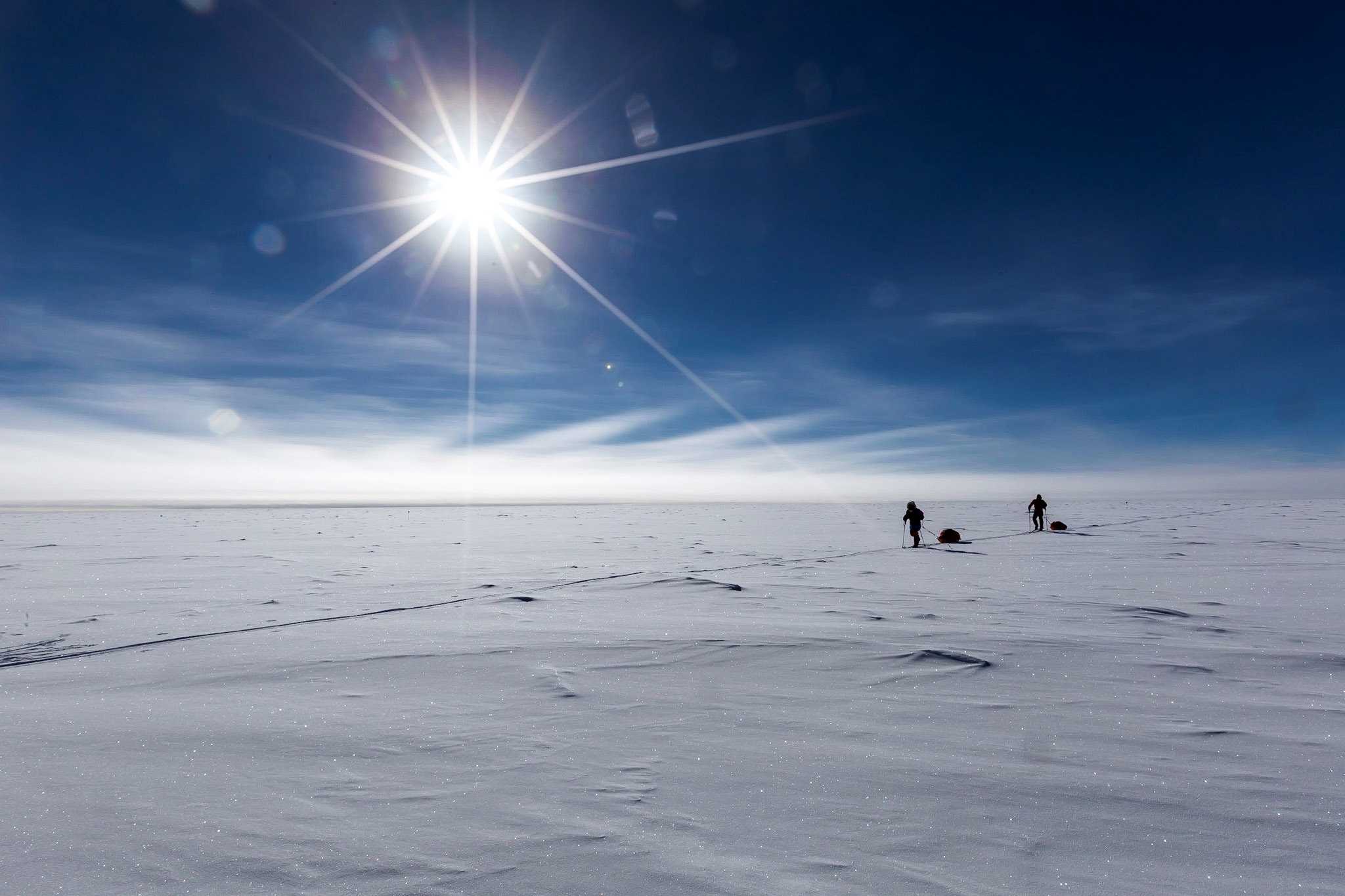
Of the ample adventures to dream of in this world, there are very few which appeal to the spirit more than an opportunity to travel unencumbered in the Antarctic continent.
This incredible journey to the southernmost point on earth involves an expedition of up to 66 mesmerising days.
An expedition of unspoiled beauty and isolation not often found in today’s world; this is a highlight trip for those with a healthy work ethic and a genuine sense of adventure! This is anything but an expedition for the lighthearted as it entails vigorous activity for a very extended period.
Once established at the edge of the Antarctic continent, we travel totally non-mechanised, with all team members hauling sledges and becoming fully immersed in the challenge.
This expedition is open to all outdoors people with experience in cold conditions and a background in climbing or backcountry skiing coupled with an ability to be a valuable team member.
- One of the world’s ultimate adventures
- Choose from three route incredible options
- Achieve a truly unique and committing objective
- Incredible vistas to the end of the world
Polar Experience
2,835m/9,301ft
54 to 66 days.
Preparation of food and equipment, review the route and expedition plan, weighing & loading of gear and briefings
Fly to Union Glacier, Antarctica
Acclimatisation and training days
Daily ski touring towards the Thiel Mountains
Expedition ends, depart for home
Prepare food and equipment, review the route and expedition plan, weigh and load gear, briefings
Fly to Messner Start and ski to Thiel Corner Skiway
Ski from Thiel Corner Skiway to the South Pole
Fly to Punta Arenas, Chile
Departures and Pricing
Looking for a specific date? Book a private expedition
An essential ingredient for participants is physical fortitude for working hard in a high-altitude, cold-weather environment, hence each member must be extremely strong and healthy. Team members will haul sleds weighing (initially) around 75kg/165lb of provisions as well as both personal and group equipment. Each day will be long and arduous, and all team members must possess sufficient strength and fitness to be able to contribute to establishing camp, putting up tents, and cook meals after a hard day. This can only be achieved with considerable and focused physical preparation.
Team members must be conversant in winter camping skills which includes putting up tents and camping in the snow and cooking with lightweight mountain stoves. Team members must have a full awareness of their personal parameters in extreme environments such as their food intake and hydration needs, thermo-regulation and avoidance of cold-weather-injury. Participants must have previous polar travel experience or have completed a polar travel course.
Team members must have previous polar travel experience and have completed a polar travel course.

Adventure Consultants is renowned for the quality of its service and strategy applied to high altitude expedition climbing and polar travel. Our reputation is attributed to meticulous planning and experienced logistics coordination. We have a philosophy of investing in every expedition to offer our climbers the best possible chance of success.
We employ strong and specialised Expedition leaders and support staff, whom are some of the most pre-eminent in the industry. We pride ourselves on operating with small teams, the best back-up and support available. This includes nutritious and ample quantities of food, comfortable base camp facilities, reliable communications systems and the necessary medical back up.
Many of our expedition members come to us because they have seen us in action on a previous trip and decide to opt for our level of service and proven experience. Others return because they know we do our very best to make expeditions safe and successful.
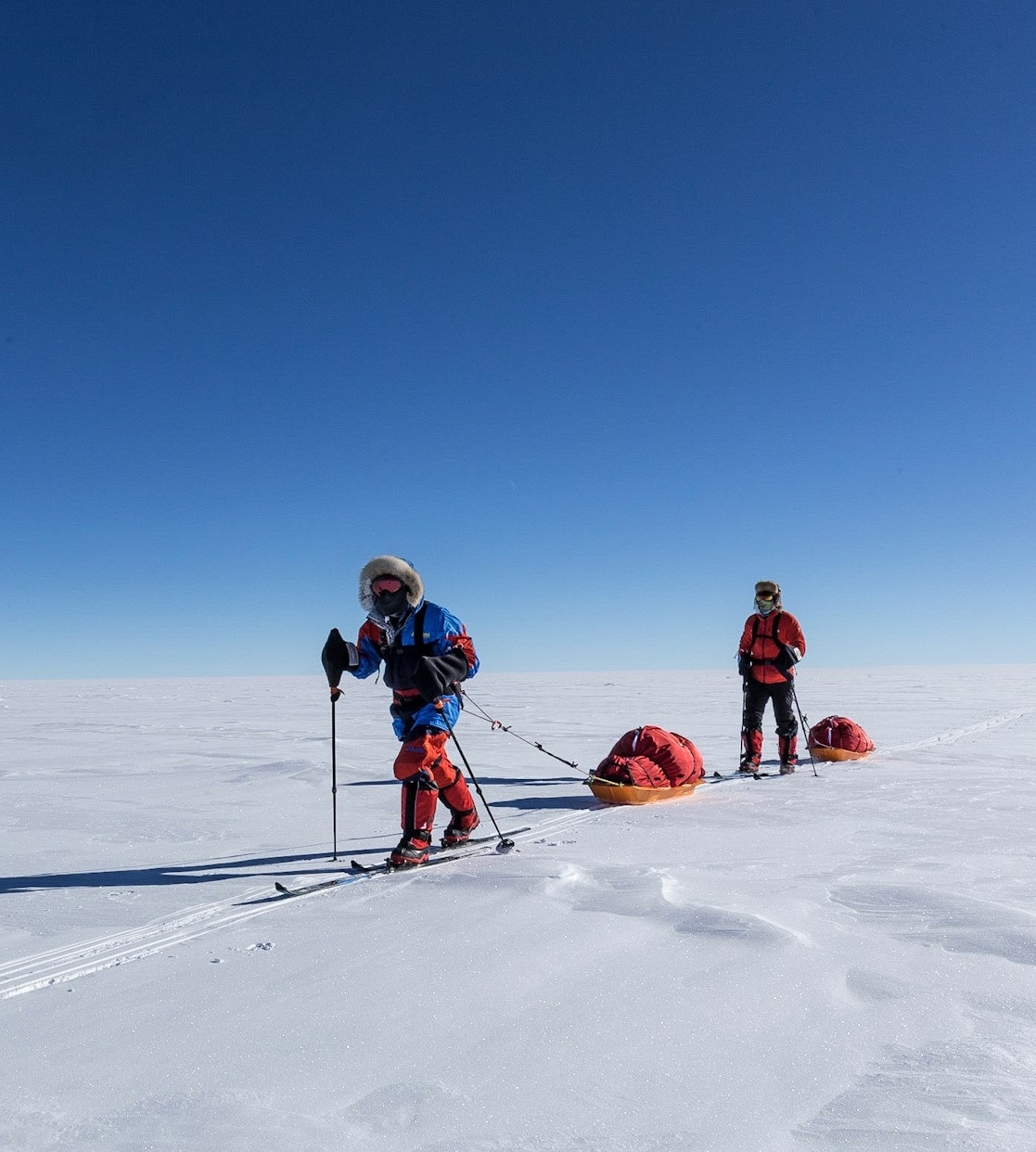
The price of your trip includes the following:
- Adventure Consultants guides
- All expedition organisation requirements
- Transport within Antarctica where applicable
- Food and tented accommodation ex Punta Arenas (twin share)
- Expedition food and equipment
- Tents, stoves, sleds & harness
- Dedicated dispatch webpage updated throughout the trip that you can post onto your own website for friends & family to follow
- Transport of 30kg/66lbs of personal equipment to Union Glacier.
By todays standards, skiing All the Way to South Pole is still a considerable achievement !
The days are long, the food preparations hard, the feet and shoulders are sore, and the conditions atrocious. Where do I sign up?
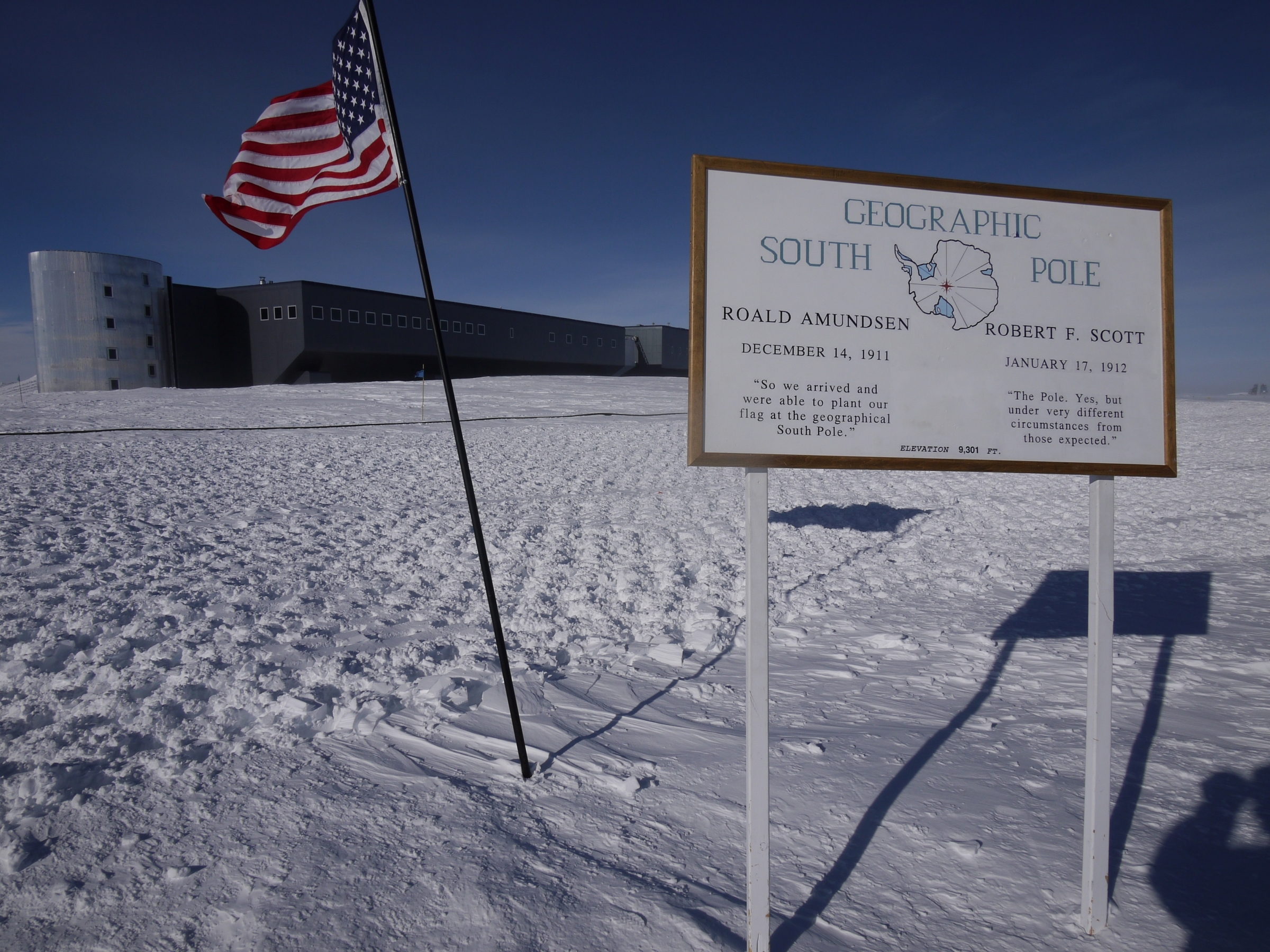
From the outset, we all yearn for the end, but when we arrive there, all we want is for the adventure to start all over again.
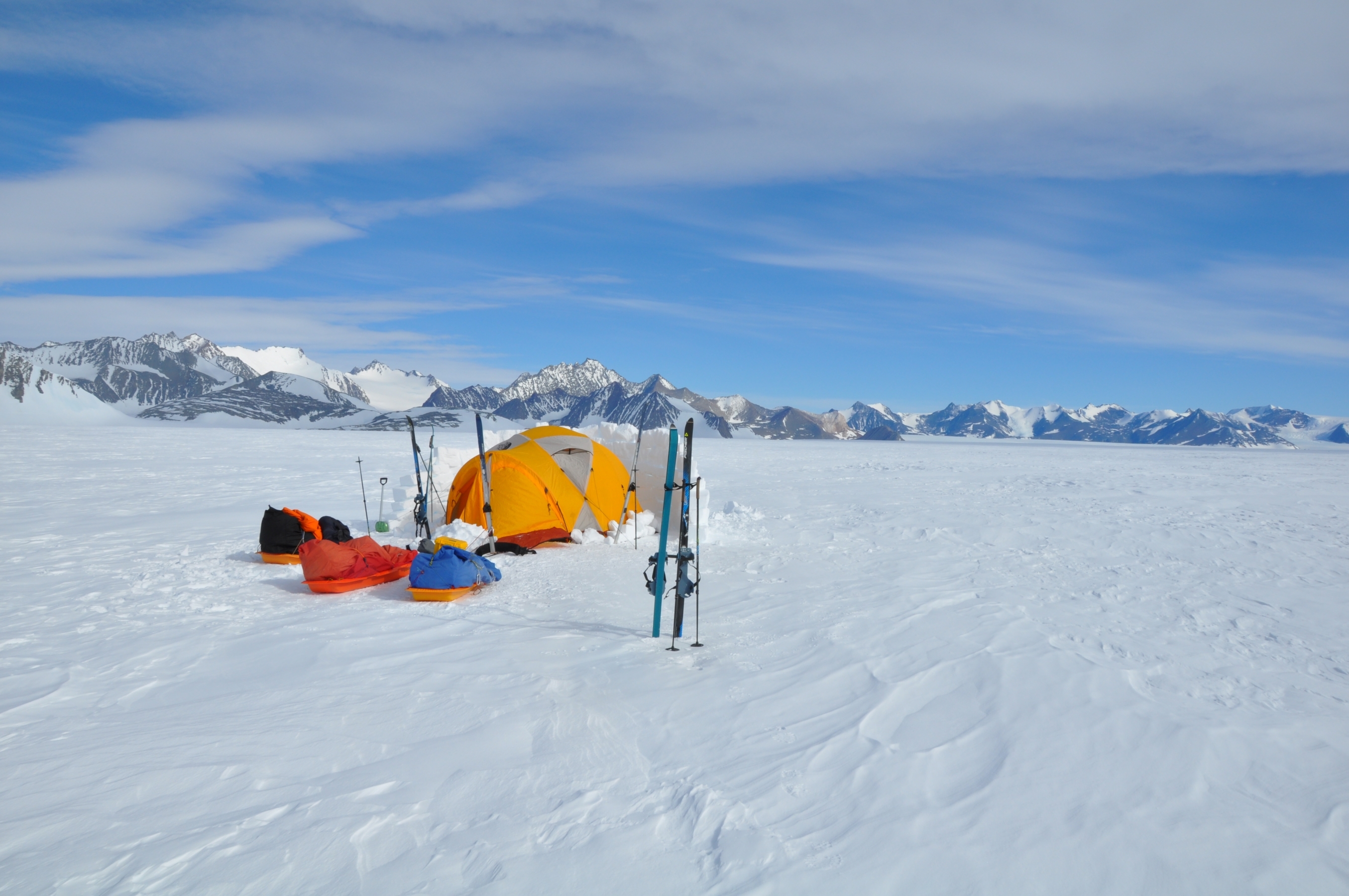
Adventure Consultants will help you prepare so you are absolutely ready to begin this great challenge .
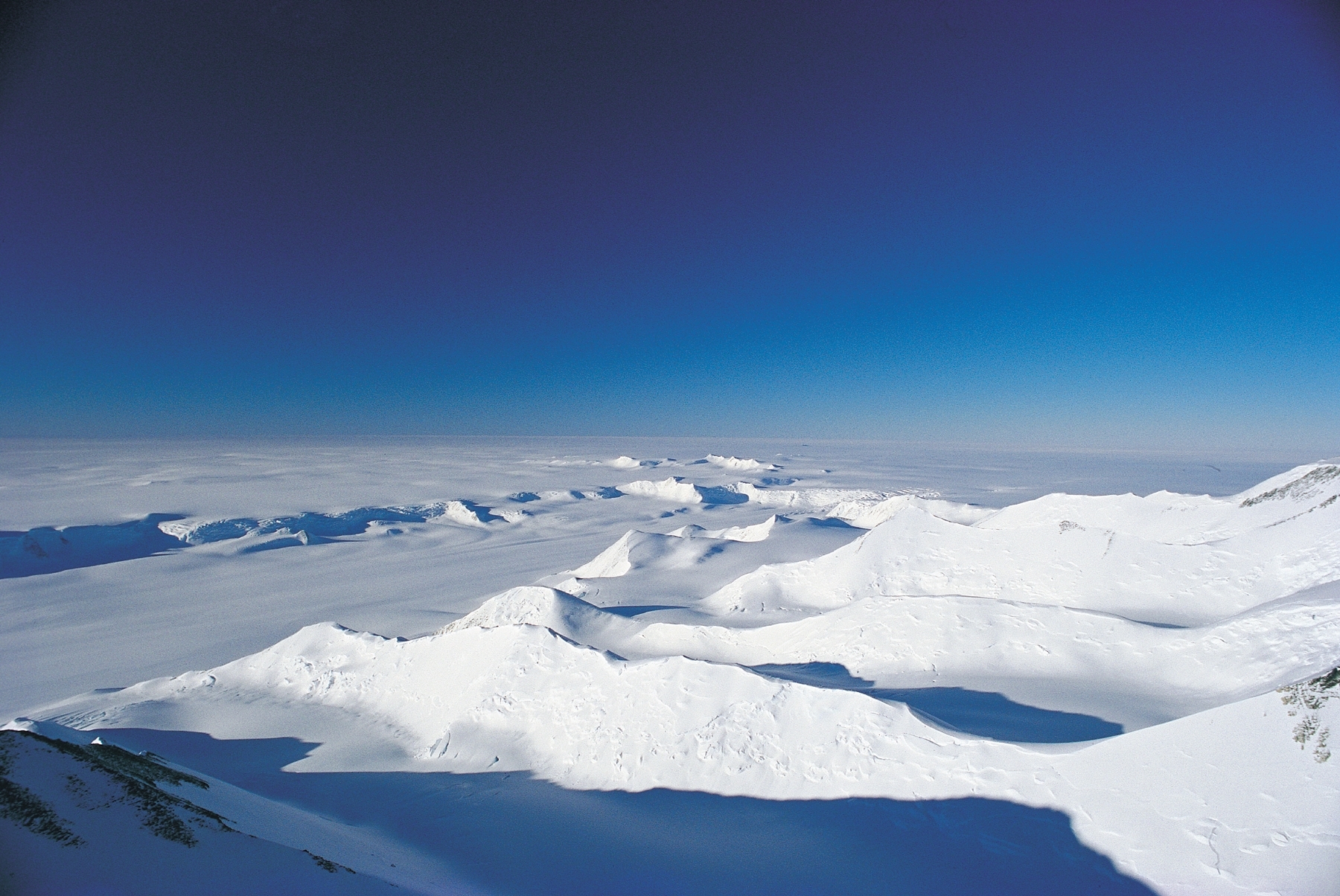
"An experience of a lifetime . Thanks!"

"We thought AC was very organized and all the little details were dealt with. AC's staff was excellent. Overall everyone was on top of their job and made our experience unforgettable."
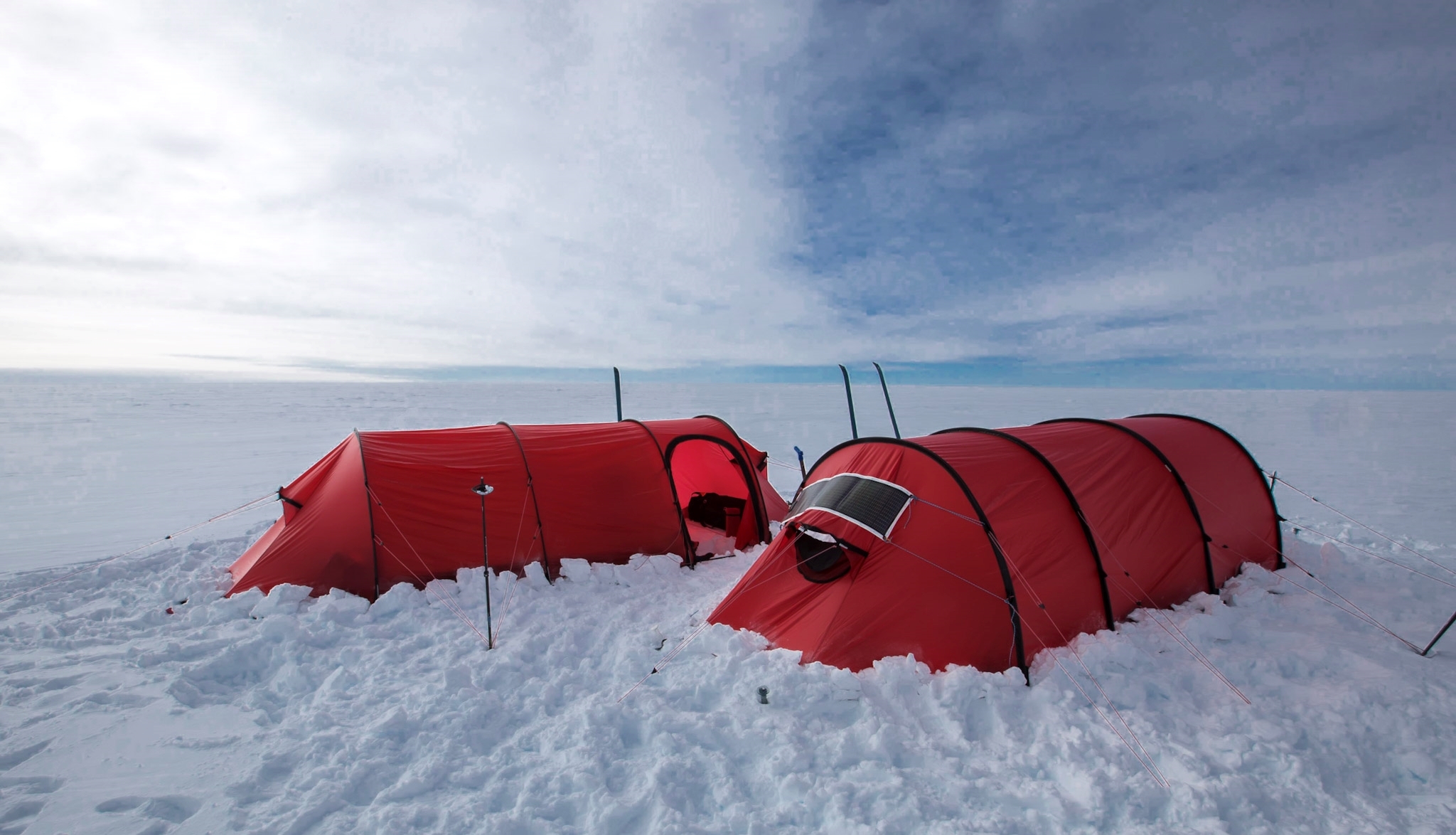
"AC is a first class outfit . They have the right people and knowledge to give their clients the best possible experience."
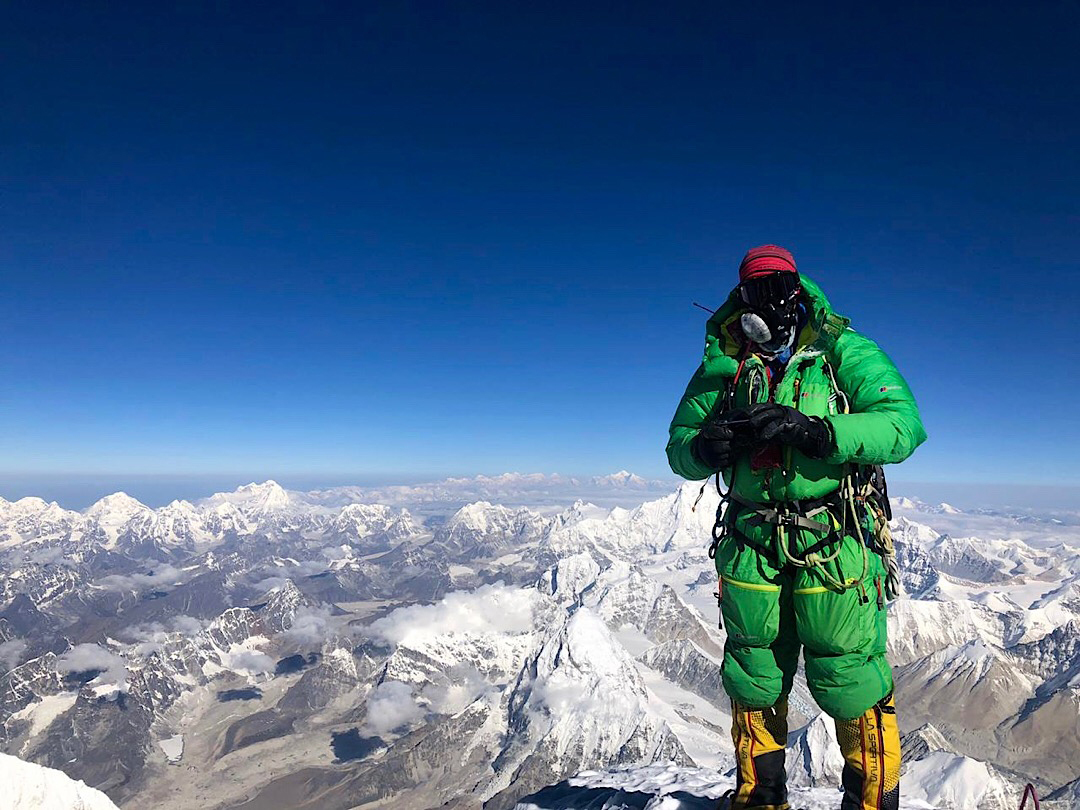
The Explorer's Grand Slam awaits! Join the exclusive club of explorer's that have climbed the Seven Summits and skied to both the North and South Poles!


Fly to the South Pole 2024/2025
Fly to the South Pole, where all 360 lines of longitude meet and in a few steps you can walk around the world. History comes alive as you stand at 90° South, the ultimate goal of polar explorers Amundsen and Scott. Imagine how it felt to head out across the frozen continent and into the unknown over 100 years ago. Feel the spirit of determination and discovery that has inspired a century of Antarctic exploration and scientific research. Now can you be one of the selected few that have set foot on the Geographic South Pole.
Day 00: Arrival Day, Punta Arenas, Chile
Day 0: pre-departure day, luggage pick-up & briefing, day 1: fly to antarctica*.
You will be called at your hotel in the morning to get a update of the current conditions in Antarctica. If the weather is suitable for the flight, you will be picked up at your hotel within the hour.
At the Punta Arenas airport, you will board the chartered jet for the 4¼ hour fl ight to Antarctica. The route crosses the Drake Passage, then follows the west side of the Antarctic Peninsula and the spine of the Ellsworth Mountains. You land on a naturally occurring blue-ice runway on Union Glacier where you will take your fi rst steps on Antarctica, then c limb aboard one of the specially-adapted vans for the 5 mi (8 km) shuttle to the camp. The staff will provide a welcome tour of the camp and show you to your tent.
*Every effort will be made to keep to the scheduled flight date and you will depart as soon as weather and runway conditions permit. Please understand that delays are common in Antarctic travel. All flights are dependent on weather, aircraft serviceability, and local conditions. The staff will stay in close contact with you and will provide you with regular flight updates.
Day 2-5: Explore Union Glacier
During your week stay in Antarctica, you’ll have multiple days to explore Union Glacier. The meteorologists will carefully monitor the weather conditions and find the best day for your South Pole Flight. A typical day at Union Glacier starts with a briefing after breakfast where you’ll meet with your guide to discuss the day’s options and choose an activity tailored to the weather and the group’s interest. Union Glacier excursions can include any of the following destinations:
Elephant’s Head Ride in one of our vehicles to this dramatic marble buttress overlooking the blue-ice runway. Beautiful ice pools and moraines offer endless opportunities for photography. If you’re looking for something more active, you’ll have the opportunity to hike up to the base of Elephant’s Head or all the way to the top of Rhodes Bluff for panoramic views of Union Glacier and the Heritage Range.
Drake Icefall Named in the 1960s after geologist Benjamin Drake IV, this impressive icefall tumbles off the polar plateau into Union Glacier. Winds from the South Pole carve huge waves into the blue-ice and polish the surface into a high shine.
Charles Peak Windscoop Discover the power of wind on ice as you wander through a sparkling turquoise corridor. If you’re truly adventurous, this is a prime place to try ice climbing with one of our experienced guides. For the less vertically inclined, you can rock hunt to your heart’s content. Just remember to leave them in place, as nothing may be removed from Antarctica.
The Beach at Rossman Cove Another spectacular setting for blue-ice photography and panoramic views! Take cross-country skis with you or a picnic lunch and enjoy Antarctica’s version of a glacial beach getaway.
Hidden Valley The staff’s favorite getaway — this secret canyon opens up to a beautiful valley prime for hiking, climbing, and backcountry skiing.
If you’d prefer to stay closer to camp, there are a variety of activities for all abilities. You can check out a pair of cross-country skis or a fat-tire bike and take a spin around the groomed 10k loop or you can enjoy a cup of tea, an Antarctic book, or fun game in the camp library. In the evenings, lectures are regularly offered and well as films tailored to your experience.
Flexible Flight Day - Fly to the South Pole
Once weather conditions permit, you will board a ski aircraft and head for the southernmost point on Earth! Your flight is planned to return the same day but food and camping equipment will be brought in the event weather conditions change and an overnight stay is necessary. The services team will assist you in packing your sleeping bag.
The flight to the Pole will take between 4-6 hours depending on the aircraft. You’ll fly over the high polar plateau, viewing wind affected snow called sastrugi, crevasse fields, and an endless expanse of white. You’ll pass the Thiel Mountains approximately halfway to the Pole and continue to fly over the plateau. As you near 90° South, you will catch sight of the South Pole station, a cluster of buildings surrounded by snow and sky. The aircraft lands on a groomed ski-way and you’ll deplane near the South Pole marker. Here all 360 lines of longitude meet and beneath your feet the ice is almost 10,000 ft (3000 m) thick!
The United States of America maintains a research station at the South Pole, named Amundsen-Scott Station in memory of those intrepid explorers. If United States Antarctic Program (USAP) staff are available, you will be escorted inside the research station for a guided visit.
Outside the station, you will have plenty of time to take photos at both the Geographic and Ceremonial Poles. Enjoy this special place and imagine how it must have felt to stand here a century ago with only the sound of the wind and an endless expanse of white stretching northward in all directions.
Your visit to the Pole will last approximately 3-4 hours. Given the cold conditions and altitude, this is the perfect amount of time for guests to accomplish their objectives and enjoy the experience.
Day 6: Return to Punta Arenas, Chile
When weather and runway conditions permit, the intercontinental aircraft will arrive at Union Glacier to transport you back to Chile. The sta ff will meet you at the airport and transfer you back to your hotel.
Please notice: No two Antarctic experiences are the same. This is part of the excitement and adventure of Antarctic travel. The itinerary above highlights typical activities and experiences. Exact timeline and details will vary from trip to trip. Trip length may vary by departure. Please anticipate delays and do not plan anything important after the trip and make sure you have a changable airline ticket. Allow yourself to enjoy this unique experience without the stress of pending commitments. The trip is operated by Antarctic Logistics & Expeditions.
Accommodation

Union Glacier Camp
Our main Antarctic base camp lies on the broad expanse of the Union Glacier, in the southern Ellsworth Mountains. We are a short flight from Mt Vinson, the highest peak in Antarctica, and just over 600 miles (1000 km) from our nearest neighbors, the South Pole. Majestic peaks rise in all directions, offering scenic excursions, technical climbs and ski tours. At camp there is little wind, providing a comfortable environment to relax and take it all in.
Our double-walled sleeping tents are roomy, comfortable and well suited to Antarctic conditions. Each tent houses two guests who sleep in sleeping bags with mattresses, pillow and linen provided by ANI. The tents are naturally heated by the 24 hour sunlight up to 60°F (15°C). The Dining Tent is the heart of our camp. It has a complete kitchen and dining area and serves as a gathering place to enjoy tea and coffee while discussing the day’s adventures. Our chefs prepare hearty, fresh-cooked meals, baked goods, and tantalizing desserts. Self-serve snacks and beverages are available anytime. We regularly fly in fresh fruits, vegetables, fish, meats, and a variety of beers and Chilean wines from Punta Arenas, Chile.
You’ll be surprised how comfortable Antarctica can be!

Price includes
- Airport transfers in Punta Arenas, Chile
- Round trip flight to Antarctica from Punta Arenas
- Round trip flight to South Pole from Union Glacier, Antarctica
- Meals and tented accommodation in Antarctica
- Antarctic guides and lecturer
- Celebration dinner and Certificate of Achievement
- Checked luggage up to 55 lb (25 kg)
Not included
- Insurance coverage—personal, medical, evacuation, or otherwise
- Commercial flights to and from Punta Arenas
- Airport transfers outside of Punta Arenas
- Meals and accommodation in Punta Arenas
- Additional flights within Antarctica
- Personal equipment and clothing
- Expenses incurred due to delays
- Luggage over 55 lb (25 kg)
- Satellite phone charges
Departures & booking
Please do not hesitate to contact us if you have any questions or wish to make a reservation.
We respect your privacy. Please refer to our Privacy Policy for full detail.
Related blog posts

A heart-warming Polar adventure!
It is with great joy we have been able to say welcome home to our first two travellers since the start of the pandemic.

- Destinations
We offer two ways to reach the southernmost point on earth, by air and by ski. Fly to 90° South aboard a ski-equipped aircraft or embrace the spirit of early explorers with one of our challenging ski expeditions to the South Pole.
South Pole Experiences
Emperors & explorers.
Walk with Emperors and Fly to the South Pole
Experience two Antarctic icons in one action-packed adventure. Fly by ski aircraft to the Gould Bay Emperor Penguin Colony on…
Activity Level
Upcoming departures, dec. 04, 2024, south pole flights.
The Southernmost Point on Earth
Fly to the South Pole, where all 360 lines of longitude meet and in a few steps you can walk…
6 or 7 Days
Dec. 30, 2024, south pole overnight.
Wake Up at the South Pole
Fly to the Geographic South Pole, the holy grail of polar explorers, and stay overnight at the World’s Southernmost Resort.…
Jan. 10, 2025
South pole overnight at three glaciers retreat.
Combine the ultimate comfort of our Three Glaciers Retreat with a night spent at 90° S. Fly to the Geographic…
Moderate / Strenuous
Jan. 04, 2025, ski last degree.
89°S to 90°S
Ski the last 60 nautical miles (69 mi/111 km) to reach the most southerly point on Earth and experience firsthand…
12 or 13 Days
Extremely strenuous, dec. 07, 2024, dec. 18, 2024, ski south pole - messner start.
Test Your Limits
Embark on an expedition that will test your strength, endurance, and resolve to join an elite group who have arrived…
Nov. 18, 2024
Ski south pole - hercules inlet.
The Ultimate Challenge
Embark on an expedition that will test your strength, endurance, and resolve and join an elite group who have arrived…
Ski South Pole - Axel Heiberg
In the Footsteps of Amundsen
Test your limits on an extreme expedition marked by deep snow, steep climbs, and complex route-finding. Traverse the same terrain…
Please inquire
Ski south pole - less traveled.
While many teams choose to start their Ski South Pole expedition at Hercules Inlet or the 'Messner Start', there are…
South Pole Flights Add-On
Fly to the South Pole, where all 360 lines of longitude meet, and in a few steps, you can walk…
Please inquire for pricing
South pole camp, field camps, sign up for the newsletter, thanks for signing up.
Antarctica is the biggest wilderness on earth and still the least visited of all the continents. In the last 100 years since Antarctic exploration began still only around 350 people have ever made the overland journey from the coast of Antarctica to the South Pole. With Expeditions365 you can progress from partaking in one of our Polar Expedition Training Courses to undertaking a full South Pole Expedition on Antarctica.
Coast to Pole
If time is not an issue and you are looking for the ultimate polar challenge then perhaps the ultimate challenge of skiing from the coast to the Pole is for you. This 50 day South Pole expedition will see you skiing from the coast of Antarctica to the South Pole hauling everything you need to survive behind you in a sled. This expedition requires a significant commitment physically, emotionally and financially, but the rewards of that commitment are huge. This is a journey that will change you forever.
Last Degree
In an approximate three week time period you can fly from southern Chile to the Antarctic base camp at Union Glacier and from there up to 89 degrees south. The following 7-10 days are spent skiing across the remote and high polar plateau, 60 nautical miles to the Geographic South Pole. This is a challenging expedition in one of the remotest places on earth.
Trip Information
Antarctic expedition season, october to january the cost of a south pole expedition is completely dependent on the details and the route and can vary enormously from trip to trip, but as a very rough ballpark figure just to give you an idea you would probably be looking at somewhere in the region of kr500,000 per person for the last degree and kr600,000 per person for a coast to pole expedition, fitness required, you’ll need to be able to trek for 7 hours a day, sledge across vast terrain and live in -30°c temperatures, further information.
Booking Form
Medical form
Testimonials
2014 carl alvey guided me to become the youngest ever person to ski the full 700 miles from the antarctic coast to the south pole on the south pole expedition carl and i spent 7 weeks, just the two of us, in one of the most hostile places on earth. i had only just turned 16 years old and carl was like a big brother to me. i trusted him completely and he needed to trust me as well, our survival depended on that trust. those 7 weeks with carl on the ice were, without a doubt, the best experience of my life so far. in summary, carl is brilliant – he’s good company, pragmatic, a problem solver, safe, calm, funny and completely unflappable. i feel privileged to have achieved my world record with carl by my side and cannot recommend him highly enough to anyone, of any age, considering an expedition of a lifetime on the white cold stuff. , lewis clarke www.youngesttosouthpole.wordpress.com.
- History Classics
- Your Profile
- Find History on Facebook (Opens in a new window)
- Find History on Twitter (Opens in a new window)
- Find History on YouTube (Opens in a new window)
- Find History on Instagram (Opens in a new window)
- Find History on TikTok (Opens in a new window)
- This Day In History
- History Podcasts
- History Vault
The Treacherous Race to the South Pole
By: Evan Andrews
Updated: May 16, 2023 | Original: January 17, 2017

“Another hard grind in the afternoon and five miles added,” British explorer Robert Falcon Scott wrote in his diary. “Our chance still holds good if we can put the work in, but it’s a terribly trying time.”
It was mid-January 1912, and the 43-year-old Royal Navy officer was nearly 800 miles into a journey to one of the last unexplored places on the globe: the geographic South Pole. Scott’s five-man party had already endured brushes with blizzards and frostbite during their trek. They were now less than 80 miles from the finish line, but a single question still loomed over their progress: would they be the first group of men in history to reach the South Pole, or the second?
Scott’s frozen ordeal had begun over a year earlier, when his ship Terra Nova had arrived on Ross Island in Antarctica’s McMurdo Sound. His 34-man shore party was tasked with conducting scientific research and collecting wildlife and rock samples, but Scott, who had previously led an Antarctic mission in 1902, was also determined to make a run at the Pole. Before leaving on the expedition, he had vowed “to reach the South Pole and to secure for the British Empire the honor of this achievement.”

Amundsen Changes Course and Race Is On
Scott’s mission was made all the more urgent by the knowledge that another explorer was seeking the Pole. Roald Amundsen was a 39-year-old Norwegian who had spent most of his life venturing to the far corners of the globe. He had been to Antarctica in the late 19th century and later became the first man in history to sail the treacherous Northwest Passage linking the Atlantic and Pacific Oceans.
In 1909, Amundsen had announced a new expedition to navigate the ice-floe-riddled waters of the Arctic to the North Pole. He had hoped to be the first man to achieve the feat, but after the American explorers Frederick Cook and Robert Peary both claimed to have beaten him to the punch, Amundsen secretly changed his plans. Without telling his financial backers or even his own crewmen at first, the Norwegian steered his ship Fram toward Antarctica and set his sights on reaching the South Pole. Before arriving, he sent a letter to Scott, who was still outfitting his own expedition in Australia. It read simply: “Beg leave to inform you Fram proceeding the Antarctic. Amundsen.”
The Norwegian expedition enjoyed a few clear advantages in what newspapers were soon calling the “race for the South Pole.” Amundsen set up his camp on the Ross Ice Shelf in the Bay of Whales, a point that was over 60 miles closer to the Pole than Scott’s home base in McMurdo Sound. And unlike Scott, whose expedition was burdened by its scientific obligations, Amundsen was focused only on reaching the Pole and returning safely. “Science,” he later admitted, “would have to look after itself.”
After spending the early part of 1911 laying down advance caches of food and supplies for their polar journeys, Amundsen and Scott’s expeditions took shelter and spent several months waiting out the dark and frigid Antarctic winter. Amundsen later tried to get a head start by beginning his journey early in September 1911 but was forced to turn back after temperatures dipped as low as 68 degrees below zero. Finally, on October 20, 1911, conditions improved enough for his five-man team to begin their dash to the Pole. Scott got underway just a few days later on November 1.
Sled Dogs and Skis Help Amundsen Arrive First
Amundsen and Scott relied on vastly different forms of transport during their journeys. Scott employed a combination of sled dogs, Manchurian ponies and even a few motorized tractors. The machines quickly broke down, however, and his ponies grew weak in the cold and had to be shot. After sending the dogs back to camp, he and his team were forced to spend much of their journey man-hauling their heavy supply sleds on foot. Amundsen, meanwhile, relied solely on skis and sled dogs to cross the tundra. The dogs helped his men save their strength, and the explorers later killed the weakest of the animals to supplement their food supply.

Thanks to the speed of his dog teams, Amundsen’s party managed to race toward the Pole at a pace of over 20 miles per day. The Norwegians took an untested route that forced them to navigate a frozen maze of crevasses, mountains and glaciers, but by early December, they had penetrated farther into the heart of Antarctica than anyone in history. Amundsen would later write that he “had the same feeling that I can remember as a little boy on the night before Christmas Eve —an intense expectation of what was going to happen.”
Finally, on December 14, 1911, he and his companions arrived at the South Pole . The men planted the Norwegian flag, smoked celebratory cigars and posed for snapshots, but they only remained for a few days before beginning the arduous trek back to their base camp. “The goal was reached,” Amundsen wrote, “our journey ended.”
Scott Arrives, Faces Deadly Conditions
Over a month later on January 17, 1912, Scott and his weary British team finally reached the Pole. To their dismay, they spotted the remnants of Amundsen’s camp just as they were approaching. “Great God!” Scott wrote in his diary. “This is an awful place and terrible enough for us to have labored to it without the reward of priority.”
Scott had been beaten to the Pole, but his troubles were only beginning. The British team had reached their destination late in the Antarctic summer, and temperatures were dropping rapidly. They began the slow slog north, but exhaustion, frostbite and malnourishment had soon spread through their ranks. On February 17—more than 20 days after Amundsen’s group had returned to their base camp—a man named Edgar Evans became the first of the British party to die.
The severely frostbitten Lawrence Oates followed a month later after sacrificing himself in a blizzard to avoid slowing down the team. “I am just going outside and may be some time,” he said before leaving the group’s tent and vanishing.
Scott: 'I Do Not Think I Can Write More'
Scott, his friend Dr. Edward Wilson and another man Henry Bowers gamely continued the journey for another few days, but temperatures continued to plunge, and they were later caught in a blizzard only 11 miles away from one of their supply depots. All three would perish in their tent just days later. “We shall stick it out to the end, but we are getting weaker, of course, and the end cannot be far,” Scott wrote in his last diary entry. “It seems a pity, but I do not think I can write more.”
By the time the bodies of Scott, Wilson and Bowers were found later that November, Roald Amundsen had already returned home in triumph and embarked on a lecture tour. Despite having won the race without losing a single man, he was in many ways overshadowed by Scott, whose doomed march had made him a hero in his native Britain. Undeterred, Amundsen continued his wandering and eventually explored the Arctic both at sea and in a dirigible, which he used to reach the North Pole in 1926. Two years later, he died in a plane crash while searching for a missing explorer over Norway’s Svalbard archipelago.
Explorers continued to venture to Antarctica in the years after Amundsen and Scott’s legendary race, but it was not until 1956 that an expedition once again stood on the South Pole. The world’s southernmost point has been continuously inhabited ever since, and its two earliest pioneers are now honored in the name of its permanent research facility: the Amundsen-Scott South Pole Station .

Sign up for Inside History
Get HISTORY’s most fascinating stories delivered to your inbox three times a week.
By submitting your information, you agree to receive emails from HISTORY and A+E Networks. You can opt out at any time. You must be 16 years or older and a resident of the United States.
More details : Privacy Notice | Terms of Use | Contact Us
- Search the site Search the site
- Join a trip
- South Pole & Antarctica
South Pole Ski Last Degree
South Pole Ski the Last Degree is a trek across 60 nautical miles (111km) of the Antarctic plateau to the most southerly point on Earth. Encapsulating the pinnacle days of a South Pole expedition, you will experience the joy of reaching the South Pole on foot, as did the early pioneers.
- Gateway Punta Arenas, Chile
- Distance 111km
- Days on Ice 12 or 13
- Daily Distance 14km / 7.6nm / 8.6m ave
- Temp. Range -20 to -30°C
- Sled Weight 35-45kg
- Challenge 5 What's this?
- Conditions Snow fields, sastrugi, altitude
- Challenges Daily distance, cold management, altitude
Trip Itinerary
Punta Arenas, Chile
Luggage pick-up, briefing and Covid testing
Fly to Antarctica
Expedition preparations
Fly to 89ºS
Ski to the South Pole
Arrive at the South Pole
Flight from South Pole to Union Glacier
Flight from Union Glacier to Punta Arenas.
Subject to change based on weather and flight conditions.
- Airport transfers in Punta Arenas, Chile
- Round trip flight to Antarctica from Punta Arenas
- Flight to 89°S from Union Glacier
- Flight to Union Glacier from South Pole
- Meals and tented accommodation in Antarctica
- Camping and skiing equipment
- Expedition Guide
- Celebration dinner and Certificate of Achievement
- Checked luggage up to 55 lb (25 kg)
- 20% discount on select Icetrek equipment
- Insurance coverage—personal, medical, evacuation, or otherwise
- Commercial flights to and from Punta Arenas
- Airport transfers outside of Punta Arenas
- Meals and accommodation in Punta Arenas
- Additional flights within Antarctica
- Personal equipment and clothing
- Expenses incurred due to delays
- Luggage over 25kg (55 lb)
- Satellite phone charges
After flying to Antarctica we spend a couple of days at Union Glacier Camp where we complete final preparations for our ski expedition.
A magical flight over the Antarctic plateau takes us to 89º South where we we begin our ski journey south to the pole.
A unique wilderness experience, the Antarctic plateau is like no other place on earth. With temperatures between -20 and -30C the cold is ever-present but comfortably so in state-of-the art cold weather clothing and equipment. In true polar fashion, you tow manageable sleds containing all your food and equipment (approximately 40kg).
You will experience twenty-four hour daylight so there's no shortage of time to really see and feel the true Antarctica. We average around 20 kilometers per day on the 111km trek, making our way south, working as a team, immersing ourselves into the Antarctic elements, camping in expedition tents, seeing the high Antarctic hinterland as it has been for millennia.
We arrive at the Amundsen-Scott South Pole Station, the most southern people on Earth. It's an achievement that you will feel justifiably proud of.
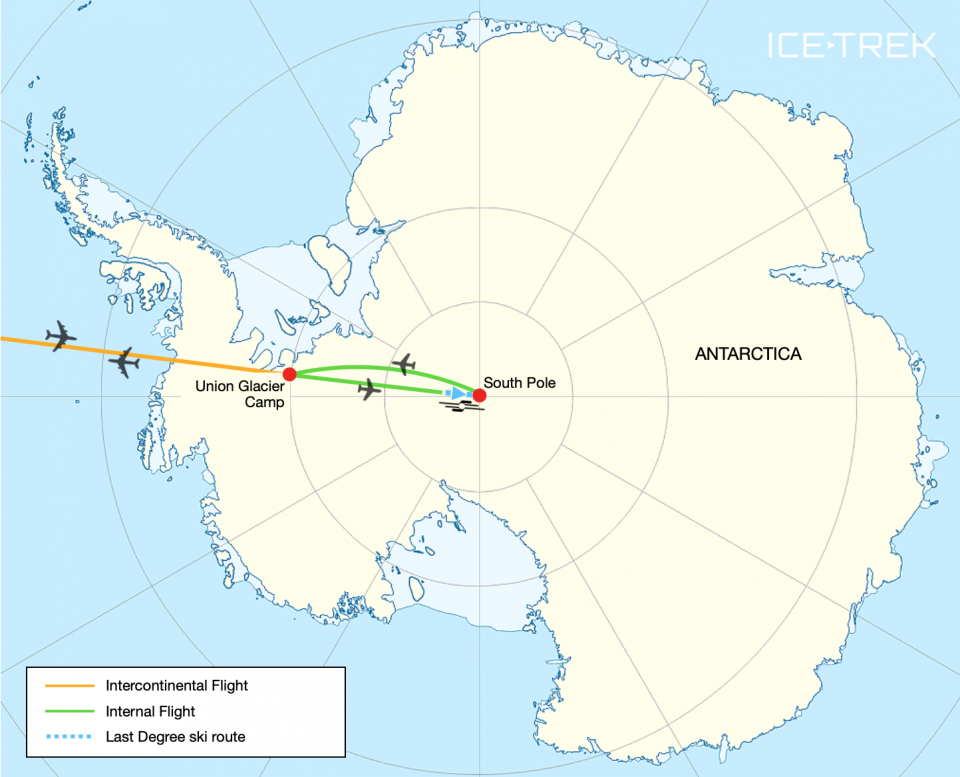
We wake around 6am and a call goes out to all of the tents. The temperature inside the tent is usually pleasant, if the sun is shining sometimes it can be hot! We camp in pairs so while one lights the stove the other has the luxury of snoozing a little longer. But eventually everyone is sitting up in their comfortable camp seats, enjoying the warmth and sipping on a hot tea or coffee.
A hearty breakfast of high-energy porridge with milk powder, desiccated coconut, crushed pecans and protein powder, together with butter for those needing the energy, gets us fired up and ready for the day of hauling. We call it our breakfast bomb. But we have it as late as possible so that all of its energy is available for the morning sessions. Reheating thermoses and melting snow for water is also a morning task, one that consumes a fair bit of time.
Slowly we start to pack all of our belongings, timing everything with the completion of snow melting so that once all tasks are done we can exit the tent and start packing our sleds. Hopefully we have choreographed this with the other tents so that no-one is waiting in the cold.
First session
Around 8.30am, tents collapsed, decamped and sleds packed, we clip into our harnesses, check our bearing and begin the first session of hauling. A few days into the trip and we will have found a daily routine and rhythm that suits the team, something like 4 sessions of 2 hours each with 20-minutes break in between, a little longer for lunch. Sled hauling is not very difficult when conditions are perfect, pulks often glide easily across the ice. It gets tougher when we are confronted by sastrugi and softer snow as we get closer to the pole.
Your guide is highly experienced in all situations - crevassing, extreme cold and team management are all part of his/her quiver of skills.
If it's cold we'll put on our down jackets during the breaks, over the top of the harness. A day bag containing food and drink, and anything else you might need during the day, is kept in the nose of the sled for easy access and it's not long before we're sitting on our sleds downing a selection of delicious snacks including crackers, energy bars, dried fruit and nuts, lollies and chocolate which help to keep us going during the next session. The breaks also serve as toilet stops.
Second session
After 10 minutes we are off again, heading south across the vast ice cap. There's opportunity for you to be out front, breaking trail, route finding, navigating, decision making. Don't worry, your guide is always nearby and ready to give advice or take over.
Your skis, skins, bindings, ski poles and boots are all designed for this kind of expedition. It takes a little while to become accustomed to the bulkier ski equipment, but eventually it feels very natural and it is certainly very warm. Your clothing too is designed to keep you warm and comfortable in the coldest of temperatures.
The weather can be anything from blue skies, no wind and -35c to warm, sticky blizzards where the temperature can rise to -10c. Snow, clouds, almost anything is possible up here but the closer we get to the South Pole the more likely we will have stable weather with blue skies.
We stop for lunch sitting in the shelter of our sleds and put on warm jackets and take our skis off. First task is to add hot water to our noodles so that they are ready to eat in around 3 minutes. A chunk of cheese in with the noodles provides a mouth-watering stringy melt that is both soft and delicious. The lunch break is a great opportunity to chat, or just enjoy the surroundings, whatever you like.
Afternoon sessions
We also carry goggles and a change of hat in our day bag. Blue skies and calm can switch to blizzard, or anything in between, so we need to have quick access to variations in our head and hand wear so that we stay warm and dry. The art of polar travel includes reducing perspiration to a minimum and we do this through venting - allowing the moisture to escape. Base layers wick moisture away from the skin, fleece layers continue the transfer while keeping us warm and breathable shell layers allow the moisture to escape to the outside. Zippers strategically located on our shell-wear assist in the venting process and a skilled traveler knows the importance of actively managing the moisture within. So no matter the weather, we remain in fine control of our body temperature and dampness through a balance of food, fluids and clothing.
As the day progresses we feel the onset of fatigue. And no wonder - we have travelled up to 8 hours, crossed sastrugi fields, scanned for crevasses, covering a distance of between 20 and 25km . It's time to camp.
After selecting a camp site we pitch tents. Snow is shovelled on the tent valances for added security and sealing from blizzards and a bag of snow blocks for melting is collected. After tossing anything we need for the night inside we climb in and prepare a cosy and ordered interior. Soon the stove is purring, snow is melting and damp things hang on the drying line. Soup, dinner and some squares of chocolate for desert await and banter fills the tent. For those staying in touch, satellite phones and modems are warmed and the world hears of our progress through phone calls, emails, texts and blogs. We can send images too, bringing our wonderful expedition to life for the folks back home. A daily call to Union Glacier camp keeps their expedition manager up to date and we get a weather report, which we can also download on our modem. You also have the opportunity for a digital detox, staying free from the outside world and being happy to leave your smartphone in Punta Arenas.
On average, our day is divided into three eight-hour periods. The most important one is sleep - eight hours is available if you want it. Eight hours of hauling also becomes a standard as it helps us to cover ground and pace our day. The third eight hours is anything not sleeping and not hauling - rests, lunch, chores and camp life. If we need to cover more distance during the day we can easily compress our down time to give more hauling time, but sleep is sacrosanct, critical for our health and happiness. And after all is done we turn the stove off, slide into our sleeping bags, ruffle our down jacket pillow and sleep the sleep of explorers, to awake to a new dawn and live a day in Antarctica once again.
Latam Airlines fly daily to Punta Arenas, Chile.
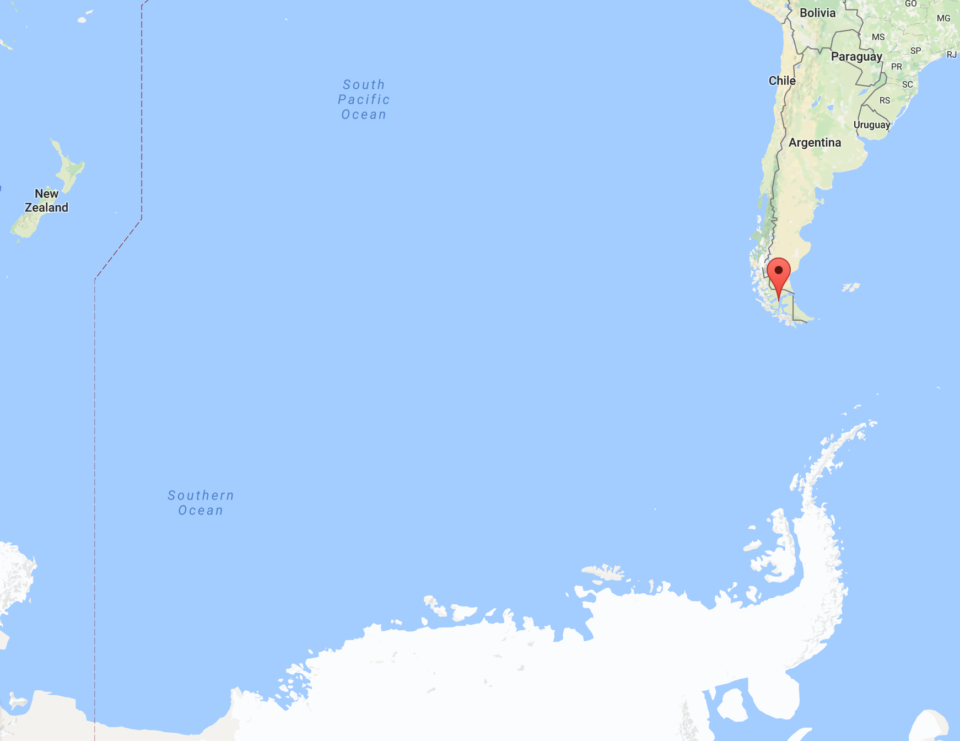
Prior to departure there will be a briefing held at the office of Antarctic Logistics and Expeditions. They are located at:
Calle Bernardo O’Higgins 568, PH: +56 9 6832 7472
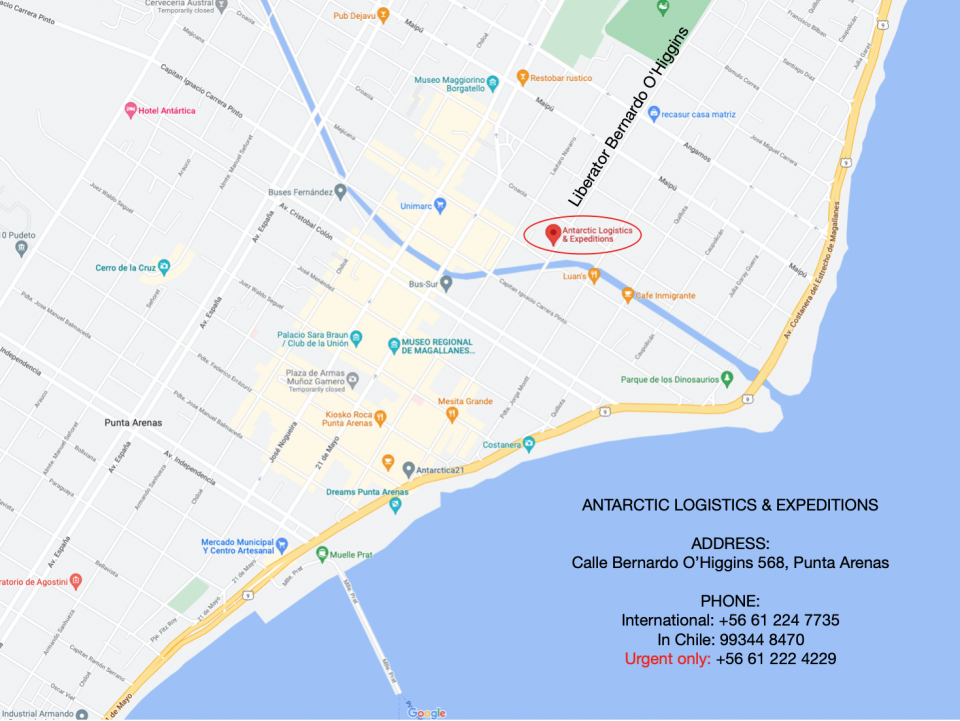
What is South Pole Last Degree?
South Pole Last Degree is a ski and sled hauling expedition on the Antarctic plateau starting at 89º south and ending at 90º south, the Geographical South Pole. The precise distance of one degree of latitude is 60 international nautical miles, 111.1 kilometres and 69.05 statute miles.
Can I leave bags in Punta Arenas?
Yes. Your bags will be collected and delivered to your past-Antarctica hotel on the day of your return.
What should I wear on the flight from Punta to Union Glacier ?
You will be briefed in Punta on exactly what to wear and bring on the flight to Union Glacier Camp . Usual airline restrictions apply.
How long is the flight to Union Glacier ?
The flight from Punta to Union Glacier takes around 5 hours.
Should I take money and my passport to Antarctica?
Union Glacier Camp sells souvenirs in USD. You are required to bring your passport as you will board an international flight to Antarctica.
What will be the temperature on arrival at Union Glacier ?
Depending on when you arrive the temperature at Union Glacier will be anywhere from -5 to -25ºC, 23 to -13ºF
How heavy will my sled be?
For a South Pole last degree expedition your sled will be 35 to 45 kg, 77 to 100 lb.
What if I am not a skier?
It’s preferable you come with some cross-country ski experience but some of our South Pole Last Degree customers have spent little time on skis. We will coach you while you are on the ice, it’s not a highly technical skill when anchored to a sled.
How long is the flight to the start point at 89º?
It’s around 6 hours from Union Glacier to 89 degrees south.
Will there be any crevasses?
No, we do not experience any crevasses.
Will there be any sastrugi?
Yes, but the biggest sastrugi are further north so we will only need to negotiate small sastrugi, not any bigger than 30cm or so.
What type of sleds do we use?
We use plastic Paris pulks with purpose-built bags strapped to the top.
What type of tents do we use?
We use Hilleberg Keron 4-person tents for two people. There is plenty of room to get comfortable but small enough to warm up quickly once the stove is operating. You are responsible for setting up, managing and taking down your tent .
Who cooks the meals and melts the snow for water?
You do! This is a normal part of expedition life. We train you how to use the stove.
What if there is an emergency and how will we communicate with the outside world?
We carry Iridium handheld phones and are in daily contact with Union Glacier Camp.
How long do we ski every day on a South Pole expedition?
We start relatively gently, skiing for around five hours on the first day. We cover this by skiing one hour, then have a short stand-up break, then another hour with a sit down break. We do the same again and have lunch and then another 2 hourly sessions before camping. When everybody feels ready we extend to 7 and perhaps eight hours per day.
How do we know when we are at the South Pole?
The Amundsen-Scott South Pole Station is positioned on the South Pole. Depending on conditions we will likely see it the day before we arrive.
Feel free to submit your own questions.
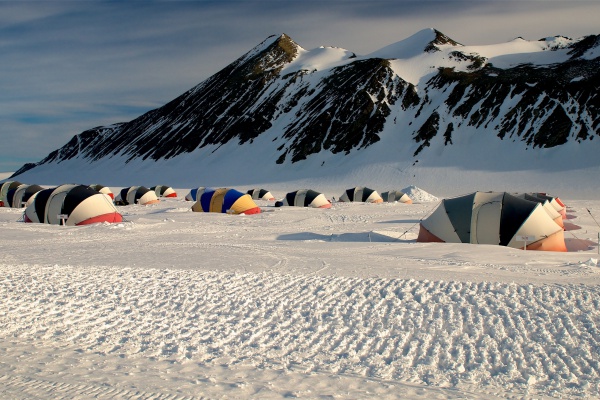
Union Glacier Camp
More south pole & antarctica.
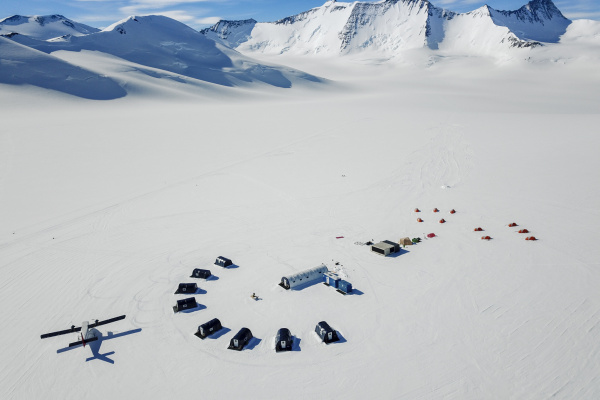
South Pole Overnight at Three Glaciers Retreat
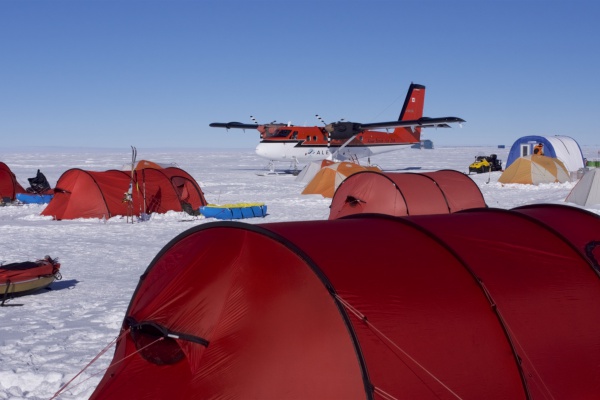
South Pole Overnight
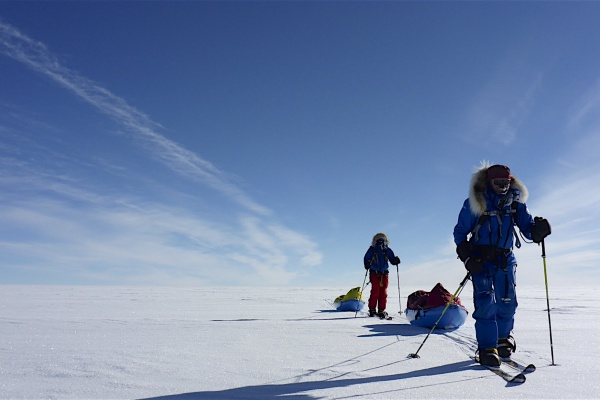
Ski Hercules Inlet to South Pole
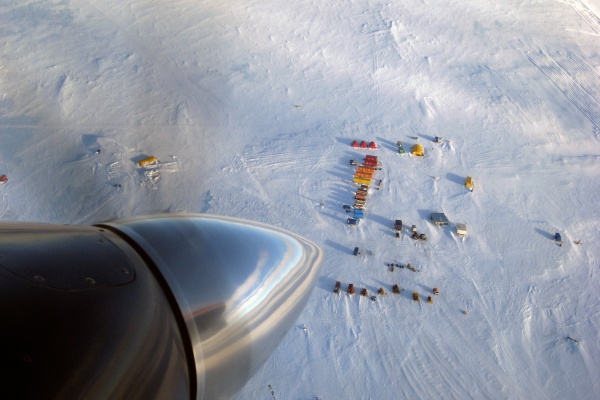
South Pole Flight
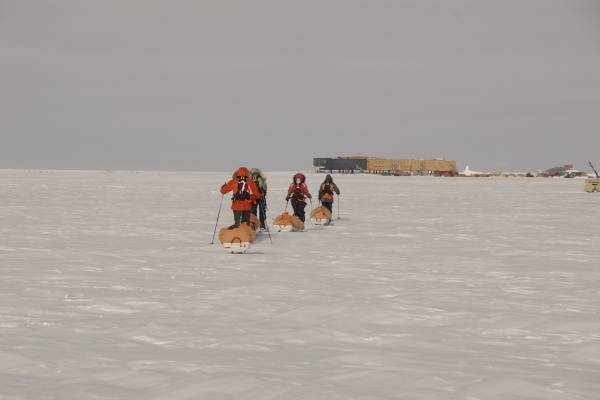
Ski Messner Start to South Pole
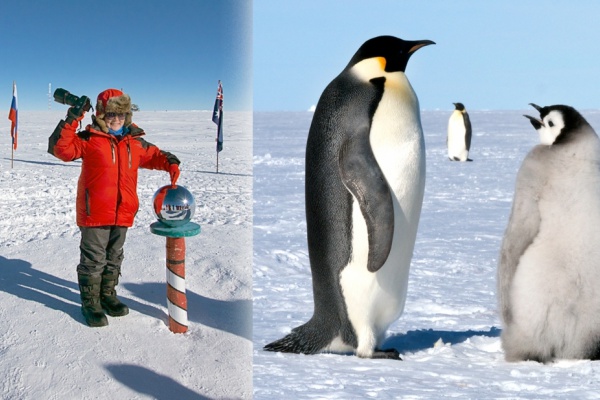
South Pole & Emperors Odyssey
- Email [email protected]
- Telephone +61 3 5754 4883
- Like us on Facebook
- Follow us on Instagram
- Follow us on YouTube
- Follow us on Flickr

- Payment & Shopping Info
- Privacy & Terms

Polar explorer Louis Rudd practices pulling his loaded “pulk,” or cargo sled. Rudd is a veteran of Antarctic traverses, having already skied a total of 2,500 miles across the continent on previous expeditions. He is vying to be the first person to cross the continent alone and unsupported.
Explorer crosses South Pole in epic race across Antarctica
Two men are dragging heavy sleds over the frozen continent's forbidding landscape in an extreme duel to make exploration history.
Right now two very different men, alone yet forever linked, are in a race against each other and history across the bottom of the world. One, Colin O’Brady, is a young American with an inspiring story and a knack for self-promotion. The other, Louis Rudd, is a middle-aged Englishman carrying on the grand tradition of his nation’s gentlemen explorers. Both are attempting to be the first person to ski across Antarctica solo, unsupported, and unaided. Only two men have attempted it, both in the past two years. One quit after 52 days, the other died.
On December 12, O’Brady passed the South Pole, roughly a day ahead of Rudd, marking the midway point in the brutal journey.
In the Great White Queen, as polar explorers call Antarctica, there are places where planes cannot reach and rescue-blocking whiteouts can last for days.
This isn’t the first time the planet’s coldest and most remote continent has hosted an epic race. In 1911, during what’s known as the Heroic Age of Antarctic Exploration, Norwegian Roald Amundsen and Briton Robert Falcon Scott set out in competing expeditions to be the first humans to reach the South Pole. After a two-and-a-half month overland journey, Scott arrived there to the bitterly disappointing sight of the Norwegian flag—Amundsen had arrived a month earlier. Scott and his four companions did not survive the return journey. Their frozen bodies were discovered in their tent nearly a year later, only 11 miles from their resupply cache. Their competition, one of history’s greatest races, captivated the world.

“The beginning was crazy,” 49-year-old Rudd wrote in one of his nightly reports. “The weight was so heavy. I’ve never pulled anywhere near that before, and I’m not getting any younger.”
Recent years have seen a flurry of heroic, self-supported traverses across what may be the planet’s most treacherous landscape. The successful ones have involved supply caches, multi-party groups, or speed-boosting kites. But a solo, unsupported crossing by human-powered means—what polar explorer Pen Hadow called the “hardest form of travel quite possibly on the surface of the Earth”—remains unachieved. O’Brady and Rudd both hope to change that. Now an Antarctic competition is once again captivating the world.
Rudd, 49, is the more experienced of the two, having already skied more than 2,500 Antarctic miles on previous expeditions. A 33-year veteran and current captain in the British Army, he most recently led a five-man team of British veterans across the continent in 2016 (with a resupply at the South Pole). After multiple tours in Afghanistan and Iraq, Rudd put the challenges of his current trek in perspective when he told The New York Times , “Nobody’s shooting at me.”
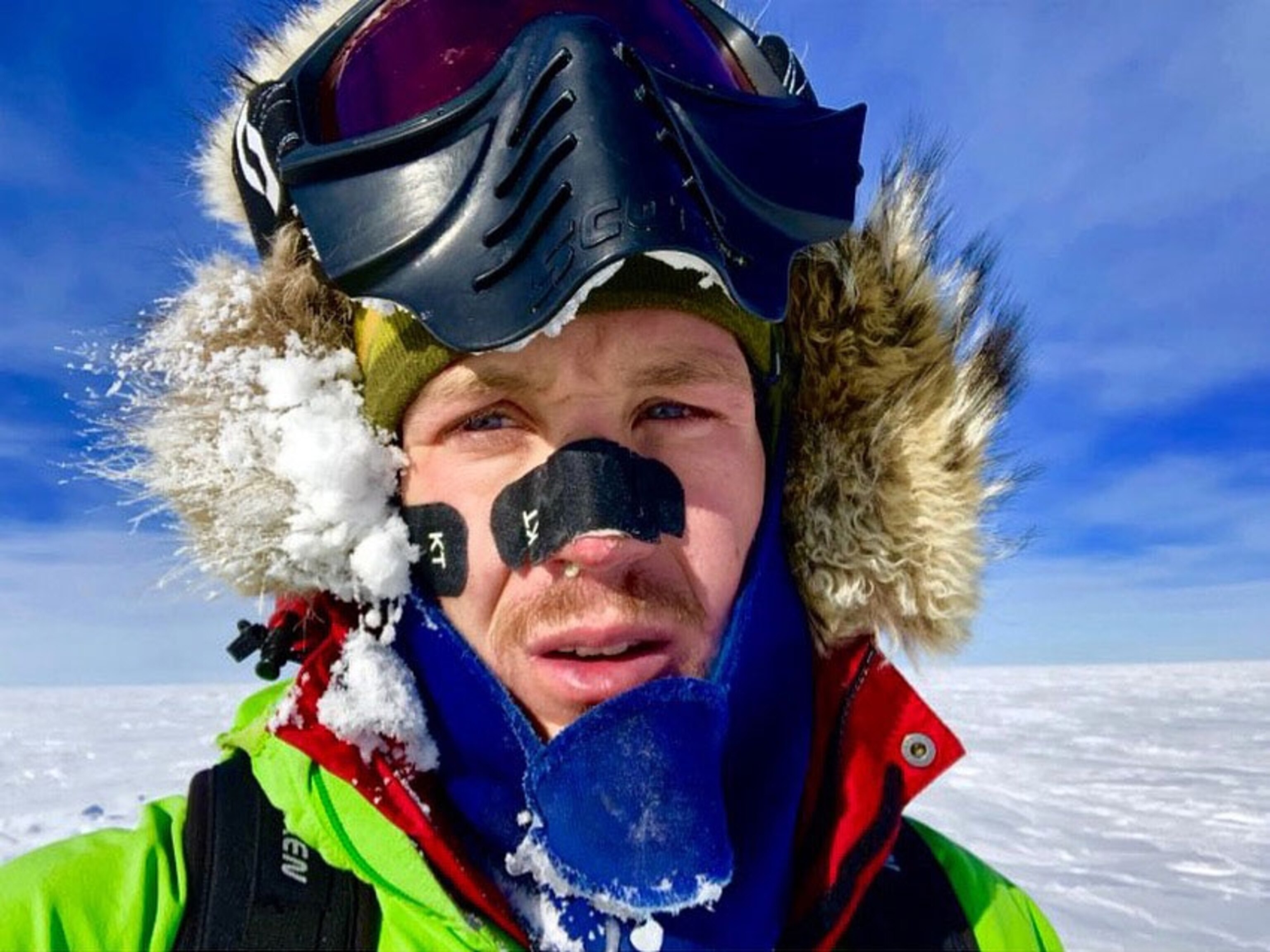
At the start of the nearly 900 mile journey, both Rudd and Colin O’Brady, 33, who is also attempting a solo, unsupported Antarctic crossing, were overwhelmed by the monumental difficulty the challenge. O’Brady wrote in an Instagram post that the fourth day of trekking was the first day he didn't cry into his goggles.
After Scott, and Ernest Shackleton, who first conceived an Antarctica traverse, and the previous two adventurers who attempted the crossing, every one an Englishman, Rudd told the British newspaper The Daily Telegraph , “It’s important a Brit cracks this first.”
They hugged farewell, possibly their last contact with another person until their journeys conclude—or, if something goes awry, ever.
It caught everyone by surprise when O’Brady, 33, a relative newcomer to the polar adventure community , suddenly declared in October his intention to attempt the crossing as well. It might be easy to discount the fresh-faced neophyte with the vocabulary of a self-help guru, but O’Brady has more than the power of positive thinking going for him. Told he might never walk again after a near-death accident burned his legs and feet in 2008, he proceeded 18 months later to win the amateur division of the Chicago Triathlon and spent the next six years as a professional triathlete, including as a member of Team USA. In 2016 he turned his sights to mountain climbing and promptly set the world record for the fastest completion of the Seven Summits, climbing the highest peak on each continent, and the related Explorers Grand Slam (Last Degree). This past summer he set the speed record for the 50 High Points Challenge, summiting the highest point in each state in the U.S. in 21 days. The man knows how to meet a challenge.
Ever the cheerful and social-media savvy self-promoter, O’Brady gives popular Ted talks and claims to be the first person to “Snap,” or use the social media site Snapchat from the summit of Everest. He posts daily updates from the expedition to his 66,000 Instagram followers. Meanwhile, Rudd phones-in updates which appear on the website of his sponsor, the British outdoor clothier named, of course, Shackleton. Both men are raising large sums for charities—Rudd for veterans, O’Brady for children’s health.

Rudd, a captain in the British military who has served in Afghanistan and Iraq, led a led a five-man team of British veterans across the continent in 2016 (with a resupply at the South Pole).
They met face to face for the first time in late October while making preparations in Punta Arenas, Chile. Any initial tensions between them dissolved over drinks in a cellar bar. On November 3, a Twin Otter ski plane deposited them about a mile apart on the Ronne Ice Shelf, a few miles out from the beginning of the Antarctic continent. They hugged farewell, possibly their last contact with another person for over a month until they reach the research station at the South Pole—or, if something goes awry, ever.
They both struggled those first days with the weight of their loads—Rudd’s sled weighed 330 pounds; O’Brady’s a hefty 375 pounds.
If that seems hyperbolic, consider the case of Henry Worsley . In 2016, he was the first to attempt the solo Antarctic traverse no one had yet dared try. He made it over 900 miles, just 126 miles from the finish, before calling for a rescue flight out. He’d pushed too hard. The grueling effort siphoned 40 pounds of his body weight and he succumbed to fatal organ failure before reaching home. To some, this suggested the journey was beyond human ability.
A fellow middle-aged British military man, Worsley was the one who’d taught Rudd the way of polar navigation when they’d retraced Amundson’s route together in 2012. In one instance, when wind blew water Rudd was drinking onto his gloved hand, freezing it in an instant, Worsley imparted a vital lesson: “Get wet, you die.” When announcing his traverse plans last spring Rudd declared it, “A fitting tribute to the legacy of Henry.”
As they set out into the great white, both men had everything they needed to survive in their pulks, or cargo sleds, for the 70 or so days they expected the approximately 1,000-mile journey to take. They both struggled those first days with the weight of their loads—Rudd’s sled weighed approximately 330 pounds; O’Brady’s a hefty 375 pounds.
“The beginning was crazy,” Rudd said in one of his nightly reports posted on the website of his sponsor, Shackleton. “The weight was so heavy. I’ve never pulled anywhere near that before, and I’m not getting any younger.”
The fourth day, O’Brady posted on his daily Instagram update, “Was the first day I haven’t cried into my goggles.”

O'Brady is skiing 12 hours most days to Rudd’s 11. Each day, both men have to carefully set up their tents, make water from snow, and dry out their clothing. On the world's coldest and windiest continent, where the temperature can drop below -50 F, any damage to their tents—their only shelter—could prove fatal.
The elevation gain only made things harder—their route starts at sea level and climbs steadily to the 9,301-foot South Pole, which sits atop a 9,000-foot-thick continental carapace of ice. Still, O’Brady strategically opted for a heavier load believing the weak link of previous attempts has been inadequate food. Briton Ben Saunders pulled the plug on his 2017 attempt at the South Pole after 52 days realizing he lacked the food to finish. With a plan to devour an astounding 7,000 to 8,000 calories a day, O’Brady likes to say he’s bringing 220 pounds of food but only a single pair of underwear.
For the first five days Rudd was in front, as many expected, but a surprising thing happened on day six. O’Brady caught up and, after a brief chat, Rudd explained he let his competitor pass because he was, “Very keen to maximize the solo experience... and kept about a kilometer apart throughout the day.”
After an arduous and unusually long 18-mile day pushing each other, Rudd decided to give up trying to keep O’Brady in sight, explaining in his day’s report, “There’s still a long, long way to go and a lot can happen yet, so I’m going to stay focused on my plan. Hopefully we’ll naturally separate, it’d be better I think to be out here on our own experiencing the solo journey as it should be.”

Rudd is motivated to finish the expedition his friend Henry Worsley was attempting in 2016 when he called for rescue and later died. Worsley was just 126 miles short of claiming the first solo, unsupported crossing of Antarctica. In honor of his friend Rudd carries Worsley's family flag with him.
While Rudd is putting in 10 or 11 hours per day on skis, O’Brady is logging 12. When Rudd emerged from his tent the morning of the seventh day, O’Brady had already decamped and left. Rudd was relieved, saying, “It’s actually a good thing for both of us—we want to do be doing our own separate solo journeys...Now I can just focus on my expedition, my journey, and kind of do it my way. That’s what I came here for.”
The following weeks served up a medley of challenges. First came the sastrugi, or knee-high, wind-created waves of snow that can slow movement to a crawl. Then 30-mile-per-hour headwinds hit and combined with the regular subzero temperatures to produce dangerous windchills of -50 F and colder. Facemasks froze solid, breathing formed tusks of ice, and eating and drinking became a challenge. Rudd had to thaw cubes of cheese in his mouth for several minutes before they could be chewed.
Besides being the coldest continent, Antarctica is also the windiest, which leaves Rudd and O’Brady on a knife edge. Potentially fatal situations can develop in an instant. If their tents were to tear or worse yet blow away while being pitched, their survival could hang in the balance. As the wind routinely whips snow into white-out conditions they keep their heads down and ski by compass into the maelstrom.
Not surprisingly, both men have had their share of spills. On November 30, Rudd was skiing into blinding winds, blowing snow obscuring even the ground beneath him, when he pitched off a three-foot sastrugi lip, crashing face-first to the ice and snapping his ski tip (both men carry extensive repair kits and Rudd even has a backup pair of skis). Fortunately for him, his pulk stayed balanced atop the sastrugi and didn’t crash down on him from behind. O’Brady, too, tumbled repeatedly, eventually stripping the climbing skin (a strip that attaches to the bottom of skis to create enough friction for uphill movement) from the base of his ski. Without the traction afforded by the skin, pulling the heavy pulk is impossible. But the ferocious wind rendered re-adhering the skin impossible, so for the first time on the expedition O’Brady pitched his tent against the storm during the day and rested.
Losing critical gear or suffering an injury could end either man’s trip, or worse. In the Great White Queen, as polar explorers call Antarctica, there are places where planes cannot reach and rescue-blocking whiteouts can last for days.
When setting up camp in strong evening winds, Rudd ties a line to his tent and clips it via carabiner to to his pulk before even removing it from the sled. Then he very carefully takes it out, erects it, throws in all his gear, and dives in for the night. If the weather allows, Rudd also plants Worsley’s family crest flag at camp, which he’s carrying on the entire trip after being loaned it by Worsley’s widow. Rudd says he gets his tent up in 10 minutes. O’Brady takes 20 minutes, in good weather. One perilous night, with 40-mile-per-hour winds, it took 90 nerve-jangling minutes.
- Nat Geo Expeditions
Once in the tent, their first task is firing up stoves in the vestibule to melt snow for water, which they store in Thermoses to keep from freezing. (O’Brady uses titanium camp pots for this; Rudd an actual tea kettle.) Both prepare protein drinks before moving on to freeze-dried dinners. While the snow melts, Rudd performs his most critical hygiene—he removes boots and socks, washes his battered feet in snow from the vestibule, dries them, and puts on foot powder and clean sleeping socks.
Procuring water from the powder-dry snow is not a fast process. Antarctica is the world’s largest desert and the areas Rudd and O’Brady are skiing across receive a scant four to six inches of precipitation a year. Though because the snow never melts—the highest temperature ever recorded at the South Pole is 9.9 degrees Fahrenheit—there’s never a shortage. To ensure their water supply, they each set out with plenty of stove fuel, around 50 pounds of white gas.
To charge electronics, like the satellite phones that are their lone link to the potentially life-saving human world beyond, they place solar panels inside the tent, which capture enough light in the 24-hour sun of Antarctic summer days to charge through nylon walls. It’s no wonder O’Brady sleeps with an eye mask, even if sleep can sometimes be in short supply. Rudd describes several nights with winds so severe he examined and stabilized his tent walls and poles hourly to ensure they held together.
Mornings present their own psychological challenges. Imagine waking in a warm sleeping bag, your tent whipping in the wind, knowing it’s at least 20-below-zero Fahrenheit outside. As Rudd describes it, “The alarm goes off and you get that sinking feeling...you know you’ve got to go out and do a full day’s slog.” (If the perpetually upbeat O’Brady ever feels this way, he doesn’t let on.) From his sleeping bag, Rudd reaches over to light his stove and begin melting snow for a 1,000-calorie freeze-dried, “porridge” breakfast. In an effort to bring some cheer, and another 500 calories a day, to his mornings, Rudd is also hauling 15 pounds of hot chocolate.

If this looks hard, that's because it is. Rudd’s sled weighs 330 pounds; O’Brady’s a hefty 375 pounds. The men fix skins to the bottom of their skis to gain traction on the snow.
If you’re wondering how they handle another common ritual in the frigid Antarctic morn, Rudd describes dashing out of the tent to go number two as “super grim.” In lieu of toilet paper, he uses chunks of snow from the hole he digs. All told, Rudd says its 90 minutes from alarm to clicking into his skis and setting out, at which point, “It’s an urgent thing to get moving, to generate some body heat.”
By the strict ethics of modern adventure, if they accept as much as a cup of water they relinquish the right to claim the traverse as unsupported.
Where Rudd uses a “grazing bag” of nuts, salami, and cheese while skiing, O’Brady has taken a typically hyper-strategic tack. For months he worked with nutritional scientists from a whole-food supplement company, Standard Process, to develop a custom, high-calorie food unit they call the Colin Bar, designed to optimize his unique performance and recovery. He started with 280 of them heaped in his pulk. That’s four a day, or more than half the calories for his trip. Though previous Antarctic adventurers have lost teeth to frozen bars before, O’Brady is convinced that, “This stuff is magic and I’m confident will be the key to success.”
He might be onto something because, as of December 12th, he’d built a day-and-a-half lead ahead of Rudd. Both men have successfully covered more than half their hoped-for distance and the vast majority of their climbing, even with the frequent white-outs and an unusual amount of fresh snow. Before leaving the warmth of civilization, O’Brady loftily declared, “This project is for anyone who has ever been told their dreams are impossible.” As he prepares to reach the South Pole, having muscled across 580 miles of polar death zone, his mission statement is now packing a bigger punch.
On day 40 of his trek, after pushing through near white out conditions, O'Brady posted a photo at the red and white striped marker that officially designates the South Pole, which is home to the Amundsen–Scott Station, a high-tech, $150 million American research facility replete with its own heated greenhouse and indoor basketball court. But don’t expect either man to look for warmth or assistance while passing by. By the strict ethics of modern adventure, if he or Rudd were to accept as much as a cup of water they relinquish the right to claim the traverse as unsupported.

On December 13, O'Brady became the first to reach the South Pole in this epic trek at the bottom of the world.
Just as important, a taste of civilization could dent the steel will needed to complete such a herculean expedition. As Rudd put it before his departure, “When I’m on the journey, I’ll accept my life for what it is. I will ski and pull. That will be my only purpose. I’ll try to forget the outside world, things like warm beds and hot showers. I’ll take the view that those things don’t exist.”
After about an hour taking a photos and “soaking in the moment,” O’Brady reattached his harness, clicked into his skis, and began pulling his sled again.
Both men will need that kind of resolve for the month and 400 miles or so of endurance that remains. Having marched from the southernmost arm of the Atlantic Ocean, they still have to ski a gauntlet of hazards to reach Pacific ice. Shortly after the Pole they will have to navigate around Titan Dome, a massive ice dome that rises above 10,000 feet. From there they march toward the Transantarctic Mountains, where they hope to thread through the peaks on glacier ramps riven with dangerous crevasse fields. Along the way, they’ll spend Christmas cold and alone, as Rudd says, “in some random spot.” At least Rudd has a “super-lightweight” present from his wife to open that he’s been carrying from the start. Regardless of conditions, the greater battle on that day may be internal.
If they can manage all of that without breakdown or mishap, they will in a month or so from now emerge onto the Ross Ice Shelf south of New Zealand and earn the title of the first humans to traverse Antarctica alone and entirely under their own power.
For his part, Rudd, appears to be increasingly feeling gravity’s pull. He has already noted his long underwear hanging more loosely on his thinning body. “I felt quite lethargic and like I was struggling,” he said in an update 60 miles from the Pole. “I guess going 37 days straight—without a proper rest day—is starting to take its toll.”
Before departing, Rudd made it clear that, “I will never allow myself to think it’s time to give up, that I can call the plane and get picked up...the only way I’m going to survive and come out of this alive is by skiing to the end point, that’s it.”
Of course, this forge-ahead-at-any-cost mentality ultimately contributed to the demise of his good friend Worsley. But if O’Brady, who so far is showing no signs of slowing down, is right that “Everyone has reservoirs of untapped potential inside of themselves,” then maybe these two adventurers have it right. However things play out between the headstrong American and the weathered Brit, new stories of adventure, suffering, and triumph are currently being written on the icy, blank canvas of Antarctica.
You can follow Rudd’s updates here and O’Brady’s here .
Aaron Teasdale, based in Missoula, Montana, is an award-winning writer specializing in adventure travel, wilderness, and conservation.
Related Topics
- POLAR EXPEDITIONS
- EXPEDITIONS
- CROSS-COUNTRY SKIING
You May Also Like

What it's like to cross Antarctica's Weddell Sea

It’s summer in Antarctica. Here’s how to explore responsibly.
Free bonus issue.

Meet the adventurer: Preet Chandi, the first woman of colour to ski solo to the South Pole

Get ready for your next iconic adventure like a pro with these tips

11 of the best wildlife cruises for 2024 and beyond

Maritime archaeologist Mensun Bound delves into 30 years of underwater adventures

This medieval village is one of the buzziest places to ski
- Environment
- Perpetual Planet
History & Culture
- History & Culture
- Mind, Body, Wonder
- Paid Content
- Terms of Use
- Privacy Policy
- Your US State Privacy Rights
- Children's Online Privacy Policy
- Interest-Based Ads
- About Nielsen Measurement
- Do Not Sell or Share My Personal Information
- Nat Geo Home
- Attend a Live Event
- Book a Trip
- Inspire Your Kids
- Shop Nat Geo
- Visit the D.C. Museum
- Learn About Our Impact
- Support Our Mission
- Advertise With Us
- Customer Service
- Renew Subscription
- Manage Your Subscription
- Work at Nat Geo
- Sign Up for Our Newsletters
- Contribute to Protect the Planet
Copyright © 1996-2015 National Geographic Society Copyright © 2015-2024 National Geographic Partners, LLC. All rights reserved
The race to the South Pole: Scott and Amundsen
Captain Scott and Roald Amundsen both aimed to be the first to reach the South Pole in 1911.
In 1911, British explorer Robert Falcon Scott and Norwegian explorer Roald Amundsen both aimed to be the first to reach the South Pole.
In the early 20th century, the race was on to reach the South Pole, with a number of explorers testing themselves in the freezing Antarctic.
In 1911, Britain’s Robert Falcon Scott and Norway’s Roald Amundsen both launched expeditions to reach the Pole. It would end in victory for Amundsen – and tragedy for Scott.
What was the race to the South Pole?
Watch more in this film series
Scott’s expedition to the South Pole
Robert Falcon Scott had attempted to reach the South Pole once before in 1902 but his party were forced to turn back due to ill health and sub-zero conditions. It was always Scott’s intention to return and, with the support of the British Admiralty and the government, he secured a grant of £20,000.
Scott recruited men from his original Antarctic voyage and from Ernest Shackleton’s ship Nimrod , which had recently returned from the Antarctic. His crew included naval seamen, scientists and paying members. His ship Terra Nova sailed from Cardiff on 15 June 1910.
History of Antarctic explorers
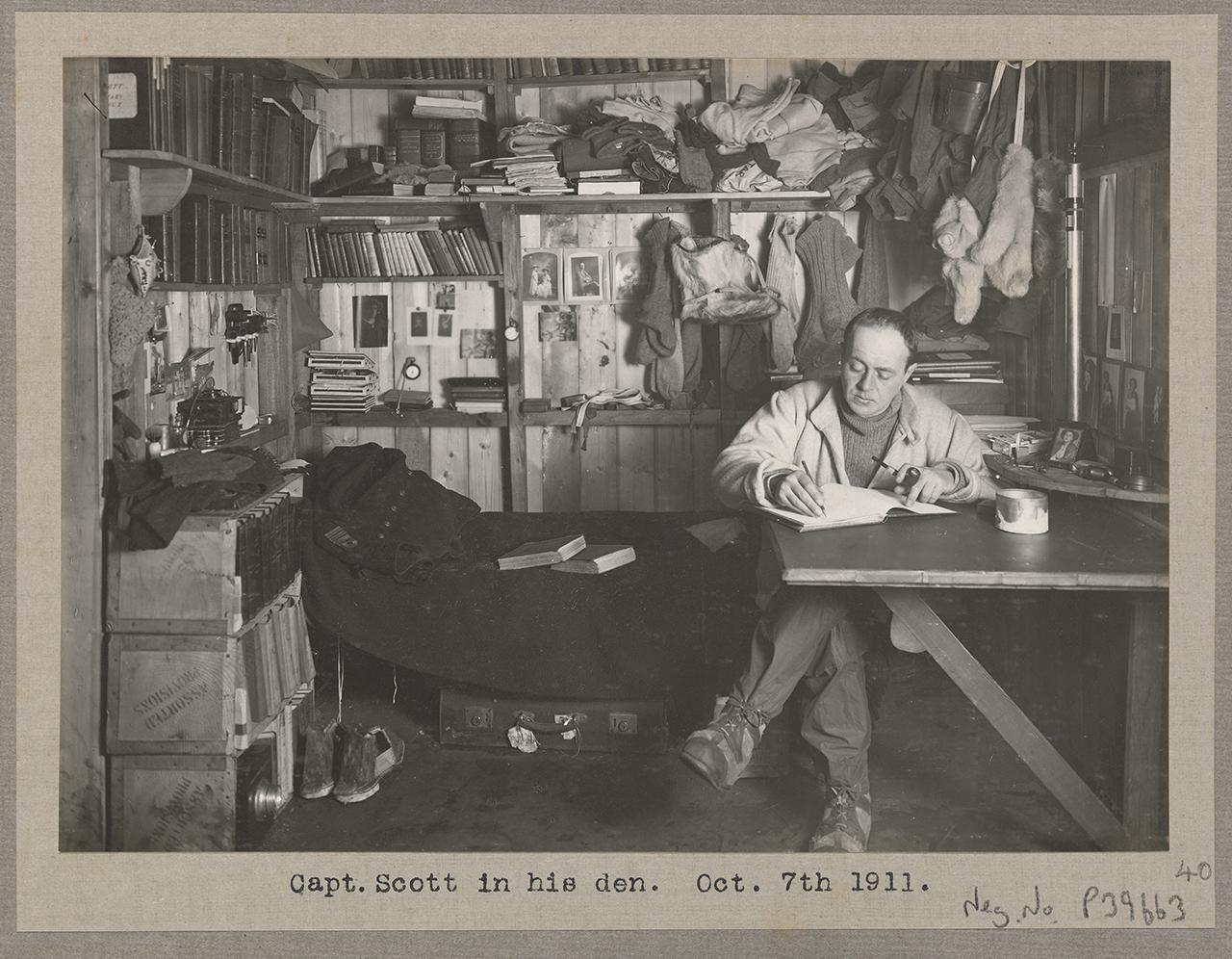
Amundsen’s expedition
Roald Amundsen was a respected Norwegian explorer who was determined to beat the British expedition and be the first to reach the South Pole. He kept his plans to head south very secret - he had originally planned to head north, but upon hearing that the North Pole had been reached, changed his mission.
Amundsen's ship the Fram reached the Ross Ice Shelf on 14 January 1911, Amundsen having chosen to land at the Bay of Whales. This gained the Norwegians a 60-mile advantage over Scott, who chose to land at McMurdo Sound.
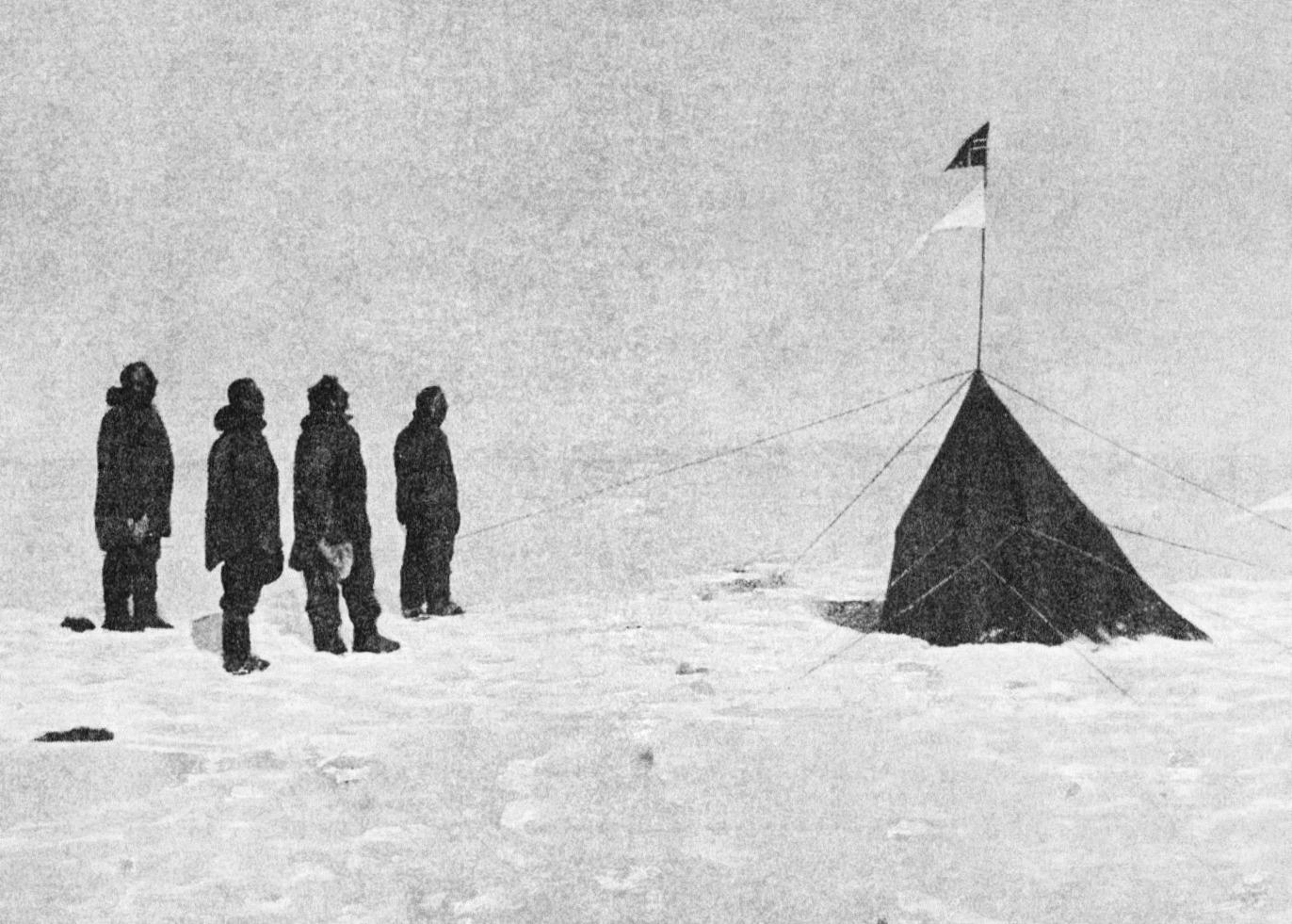
On 18 October 1911, after the Antarctic winter, Amundsen's team set out on its drive toward the Pole. Captain Scott began his trek three weeks later. At around 3pm on 14 December 1911, Amundsen raised the flag of Norway at the South Pole. He had reached the Pole a full 33 days before Captain Scott arrived. Amundsen and his crew returned to their base camp on 25 January 1912, 99 days and roughly 1400 nautical miles after their departure.
Scott left his base camp with his team to the Pole on 1 November 1911. He finally reached the South Pole on 17 January 1912, disappointed to learn that Amundsen had beaten him to it. The tortuous return journey was faced with stoicism and dignity. Weak from exhaustion, hunger and extreme cold, his last diary entry is dated 29 March 1912. He died in his tent alongside two of his men.
Amundsen’s success was celebrated worldwide, and he received personal telegrams of congratulations from US President Theodore Roosevelt and King George V of England. Scott was also recognised for his achievements and posthumously made a Knight Commander of the Order of the Bath.

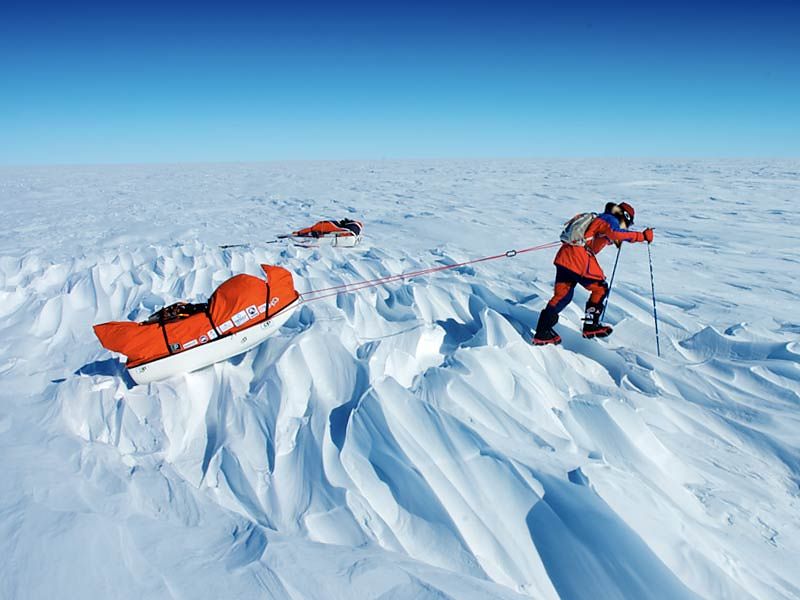
My trek to the South Pole
- global issues

COMMENTS
Journey on skis from Hercules inlet across Antarctica to the South Pole with Adventure Consultants, polar expedition specialists. Adventure Consultants. Plan your Adventure Expeditions, Treks ... Follow our Luxury Everest Base Camp Trek #2 from April 15 to 29, 2024, as the team journey up through the incredible Khumbu Valley to Everest Base ...
The history, the exclusivity, and the isolation. Join the small handful of adventurers to have checked off the mythical South Pole. Traversing Antarctica in hours by plane with magnificent views, you'll spend 4 whole days camping at the heart of…. 6-7 Days. $62,895.
Take the path less travelled. Icetrek offers exhilarating ski expeditions, treks, tours and flights to the North Pole and the Arctic, the South Pole and Antarctica. Our guides are among the best in the world, gaining decades of experience with every type of group, in every polar environment, at every level of challenge.
Fly to the South Pole 2024/2025. Fly to the South Pole, where all 360 lines of longitude meet and in a few steps you can walk around the world. History comes alive as you stand at 90° South, the ultimate goal of polar explorers Amundsen and Scott. Imagine how it felt to head out across the frozen continent and into the unknown over 100 years ago.
From coast to pole, Icetrek has an Antarctic destination just for you. Read more. We are the only company in the world to have entered Antarctica via every gateway town - Punta Arenas, Chile; Ushuaia, Argentina; Cape Town, South Africa; Christchurch, New Zealand and Hobart, Australia.And we have done so by plane, by icebreaker, by cruise ship and on board a sailing yacht.
Hikers can trek up to the base of Elephant's Head or all the way to the top of Rhodes Bluff for panoramic views of Union Glacier and the Heritage Range. ... The South Pole has been designated an Antarctic Specially Managed Area (ASMA #5) to conserve the environmental, scientific and historical values of the area. ...
South Pole. Destinations. South Pole. We offer two ways to reach the southernmost point on earth, by air and by ski. Fly to 90° South aboard a ski-equipped aircraft or embrace the spirit of early explorers with one of our challenging ski expeditions to the South Pole.
The first ever expedition to reach the Geographic South Pole was led by the Norwegian explorer Roald Amundsen.Himself and four other crew members made it to the geographical south pole on 14 December 1911, which would prove to be five weeks ahead of the competitive British party led by Robert Falcon Scott as part of the Terra Nova Expedition.Amundsen and his team returned safely to their base ...
This 50 day South Pole expedition will see you skiing from the coast of Antarctica to the South Pole hauling everything you need to survive behind you in a sled. This expedition requires a significant commitment physically, emotionally and financially, but the rewards of that commitment are huge. This is a journey that will change you forever.
The classic South Pole ski expedition. Hercules Inlet is the classic South Pole start point on the coast of the Ronne Ice Shelf. Test your skill, endurance and mental tenacity over 1130km of Antarctic wilderness as you make your way to the bottom of the world. Temp. Range -10 to -35°C.
The South Pole, also known as the Geographic South Pole or Terrestrial South Pole, ... The fastest solo, unsupported and unassisted trek to the south pole by a female was performed by Hannah McKeand from the UK in 2006. She made the journey in 39 days 9 hours 33 minutes. She started on 19 November 2006 and finished on 28 December 2006.
Here's how the gear and food of the two South Pole expeditions compare. Diet. The staple food of Scott's five-man party was pemmican, a mixture of dried beef and fat, to which water was added ...
This year, explorer Ben Saunders attempted his most ambitious trek yet. He set out to complete Captain Robert Falcon Scott's failed 1912 polar expedition — a four-month, 1,800-mile round trip journey from the edge of Antarctica to the South Pole and back. In the first talk given after his adventure, just five weeks after his return, Saunders offers a raw, honest look at this "hubris"-tinged ...
In the early 1910s, explorers Roald Amundsen and Robert Falcon Scott engaged in a frantic, and ultimately tragic, race to be the first man to reach the South Pole. Updated: May 16, 2023 | Original ...
The Trek to South Pole. You will begin your trek south of the Nunataks at Hercules Inlet. Make sure that the pilots don't drop you off too far off from the 80.00.00 starting point! An extra day or two might not be a too big deal for a supported expedition, but for you it will be hell. ... Now commence the second climb towards the South Pole ...
http://www.ted.com Extreme runner Ray Zahab shares an enthusiastic account of his record-breaking trek on foot to the South Pole -- a 33-day sprint through t...
Henry Worsley's lifetime fascination with Antarctic explorers such as Ernest Shackleton, Roald Amundsen and Robert Scott led him to retrace their expeditions...
FAQ. South Pole Ski the Last Degree is a trek across 60 nautical miles (111km) of the Antarctic plateau to the most southerly point on Earth. Encapsulating the pinnacle days of a South Pole expedition, you will experience the joy of reaching the South Pole on foot, as did the early pioneers. Temp. Range -20 to -30°C.
On day 40 of his trek, after pushing through near white out conditions, O'Brady posted a photo at the red and white striped marker that officially designates the South Pole, which is home to the ...
Captain Robert Falcon Scott CVO (6 June 1868 - c. 29 March 1912) was a British Royal Navy officer and explorer who led two expeditions to the Antarctic regions: the Discovery expedition of 1901-04 and the Terra Nova expedition of 1910-13.. On the first expedition, he set a new southern record by marching to latitude 82°S and discovered the Antarctic Plateau, on which the South Pole is ...
Captain Scott began his trek three weeks later. At around 3pm on 14 December 1911, Amundsen raised the flag of Norway at the South Pole. He had reached the Pole a full 33 days before Captain Scott arrived. Amundsen and his crew returned to their base camp on 25 January 1912, 99 days and roughly 1400 nautical miles after their departure.
My trek to the South Pole. 392,322 views | Ray Zahab | TED2009 • February 2009. Read transcript. Extreme runner Ray Zahab shares an enthusiastic account of his record-breaking trek on foot to the South Pole -- a 33-day sprint through the snow. global issues; Antarctica; TED is supported by ads and partners.